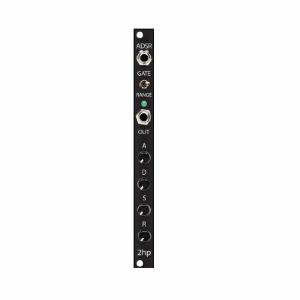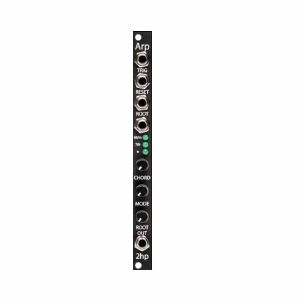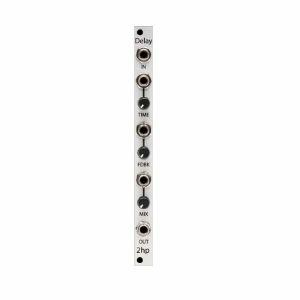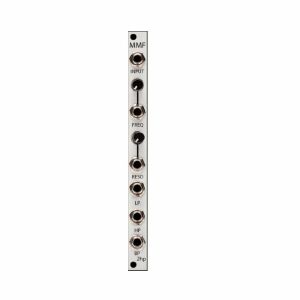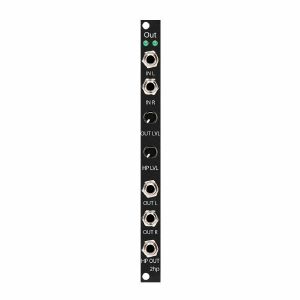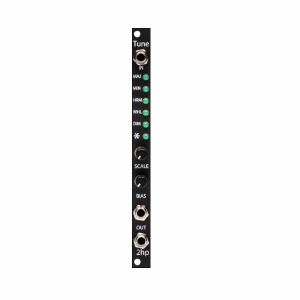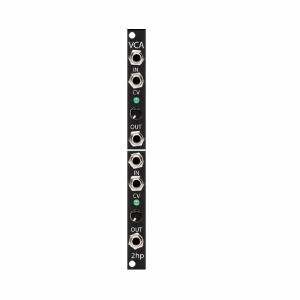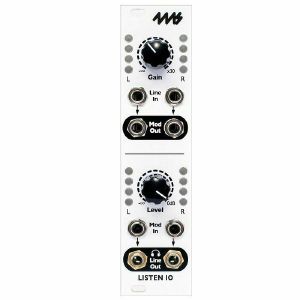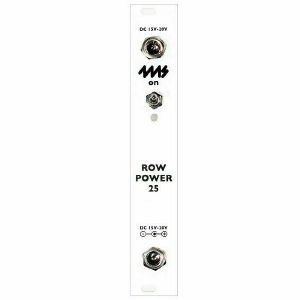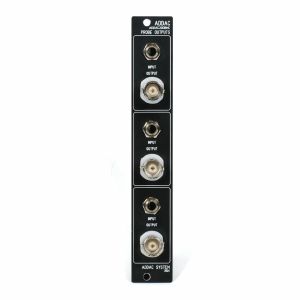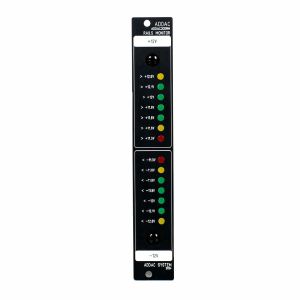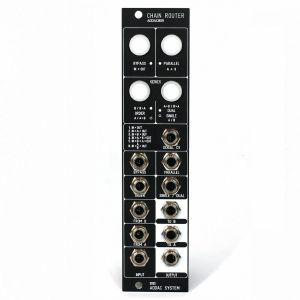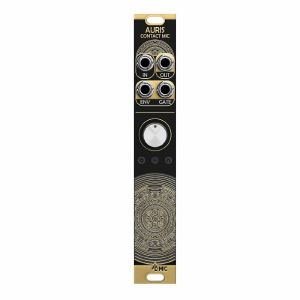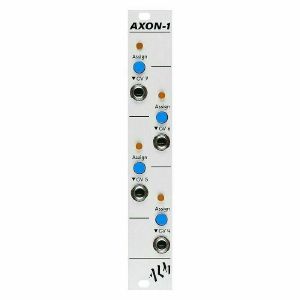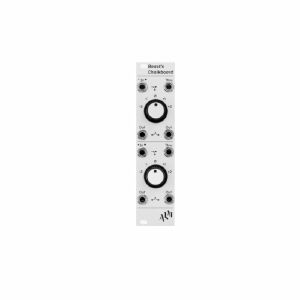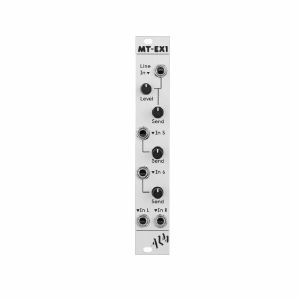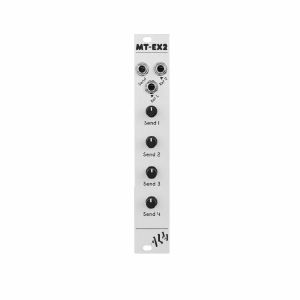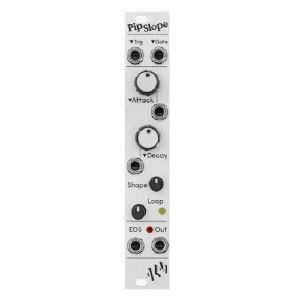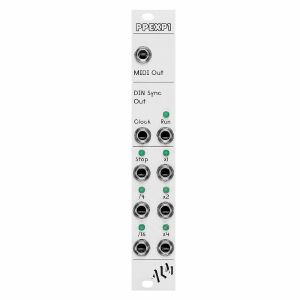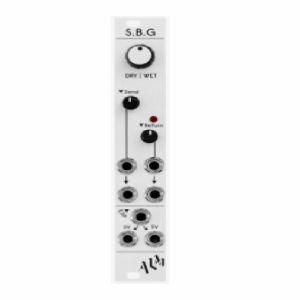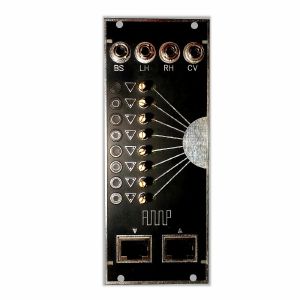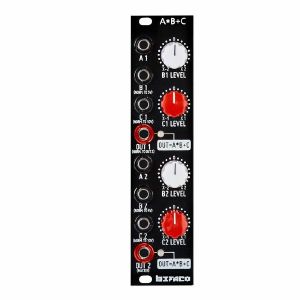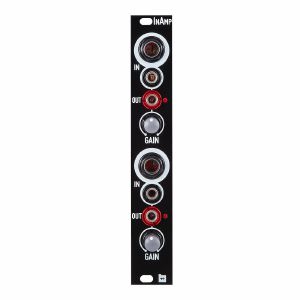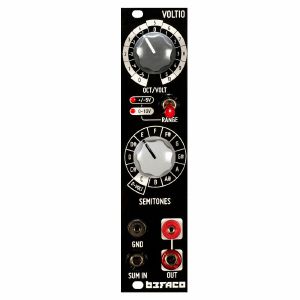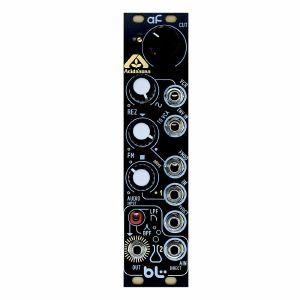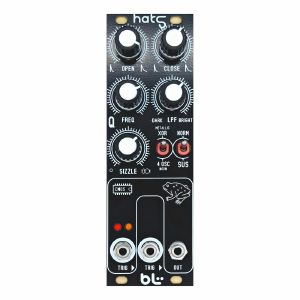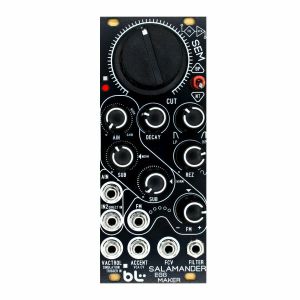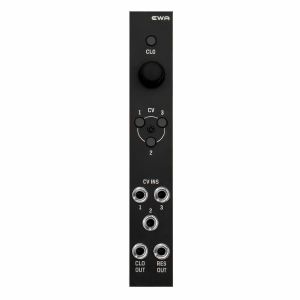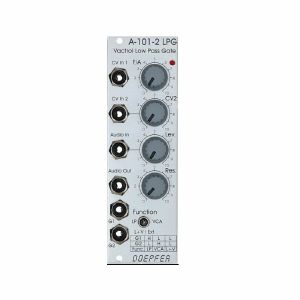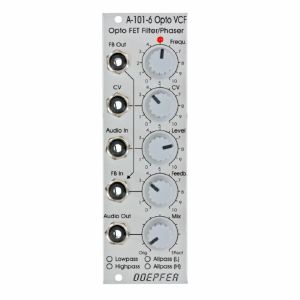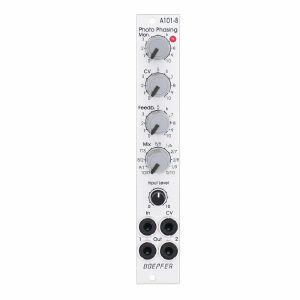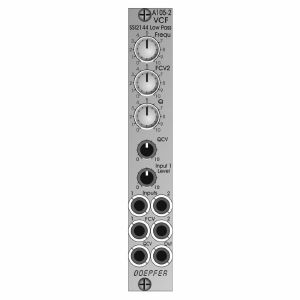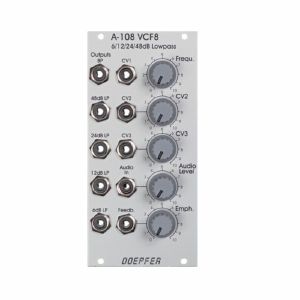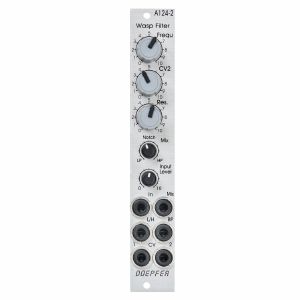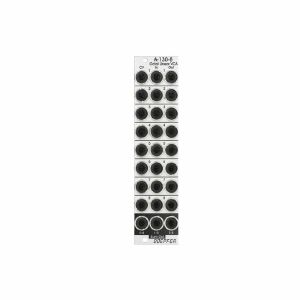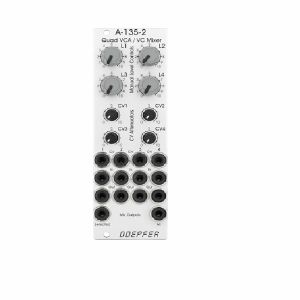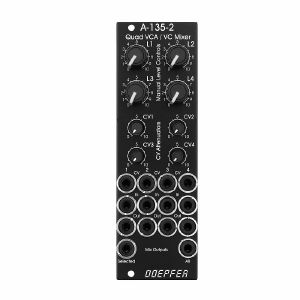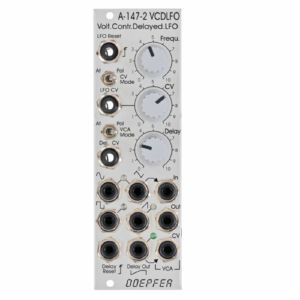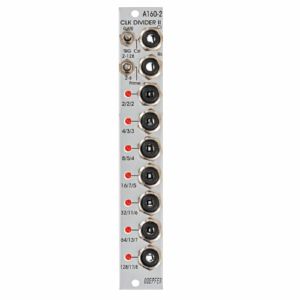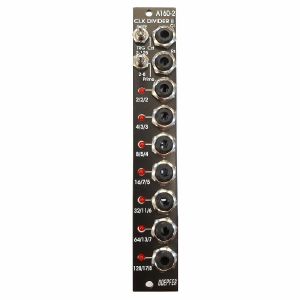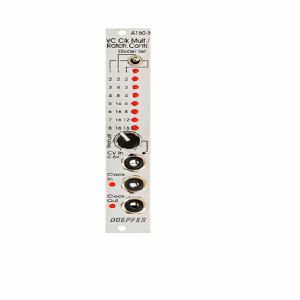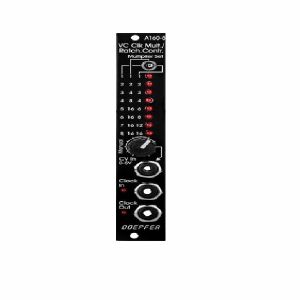Filter
Stock
Equipment
Format
Featured
Price
Tags
Back catalogue: Studio Equipment
Juno's full catalogue of Studio Equipment2hp ADSR 4-Stage Linear Envelope Module (black) (envelope generator synth module)
Cat: 686006 Rel: 04 May 18
Four stage linear envelope module in 2HP.
Notes: ADSR is a four stage linear envelope with two expressive ranges. Each stage can be modified independently allowing for the creation of complex, multi-segment envelopes. Great for modulating filters, VCAs, and oscillators.
… Read more 1 in stock $118.40
Click for better price!
or call +44 20 7424 1960
quote 686006
quote 686006
2hp Arp Gate-Driven Arpeggiator Module (black) (sequencer synth module)
Cat: 686008 Rel: 08 May 18
Gate-driven arpeggiator
Notes: Arp is a gate-driven arpeggiator with a multitude of chord types and playback modes. Voltage control over both root note and chord type allow for sequencing any combination of chords in any key imaginable.
With the rate of the arpeggio and reset capability in your own hands, you're free to create dynamic rhythmic melodies from your favourite chords. Take your tonality for a ride with Arp.
… Read moreWith the rate of the arpeggio and reset capability in your own hands, you're free to create dynamic rhythmic melodies from your favourite chords. Take your tonality for a ride with Arp.
1 in stock $120.61
Click for better price!
or call +44 20 7424 1960
quote 686008
quote 686008
2hp Delay Delay Audio Processor Module (silver) (delay/effect synth module)
Cat: 649105 Rel: 11 May 17
Full featured delay audio processor
Notes: Delay is a flexible, full-featured delay audio processor. CV over all parameters provides dynamic access to its nuanced controls. The feedback path ranges from slapback to infinity, allowing for wild permutations of the original signal.
With delay times from milliseconds to nearly two seconds, Delay is sure to find a use in every patching situation. Add subtle echo to a melodic line, or crank up the feedback and hear a bed of layered sounds to bury your listeners in.
… Read moreWith delay times from milliseconds to nearly two seconds, Delay is sure to find a use in every patching situation. Add subtle echo to a melodic line, or crank up the feedback and hear a bed of layered sounds to bury your listeners in.
1 in stock $119.50
Click for better price!
or call +44 20 7424 1960
quote 649105
quote 649105
2hp MMF Analogue Multimode Filter Module (silver) (filter synth module)
Cat: 706868 Rel: 15 Oct 18
MMF is an analogue, multimode filter with a 12dB per octave slope.
Notes: MMF is an analogue, multimode filter with a 12dB per octave slope. Its sonic character swings all the way from classic low pass to squelchy acid lines. Simultaneous outputs of low pass, high pass, and band pass filter types are provided allowing for many variations of the input signal. Whether you're looking for smooth and creamy, or resonant and wild, MMF can go there.
… Read more 2 in stock $131.13
Click for better price!
or call +44 20 7424 1960
quote 706868
quote 706868
2hp Out Stereo Line Out & Headphone Amp Module (black) (VCA synth module)
Cat: 1078540 Rel: 01 Apr 25
Stereo line out and headphone amp module.
Notes: Easily connect your modular system to the rest of your setup with Out, a compact 2HP stereo line output and headphone module. Despite its small size, it includes everything you need for clear, convenient listening.
The top section features stereo modular-level inputs with LED indicators for quick level monitoring. From there, the signal is routed to both a stereo line output and a dedicated headphone jack, each with independent volume control. Whether you're sending your modular through external effects, recording into an interface, or just monitoring with headphones, Out keeps things simple and efficient.
… Read moreThe top section features stereo modular-level inputs with LED indicators for quick level monitoring. From there, the signal is routed to both a stereo line output and a dedicated headphone jack, each with independent volume control. Whether you're sending your modular through external effects, recording into an interface, or just monitoring with headphones, Out keeps things simple and efficient.
1 in stock $104.01
Click for better price!
or call +44 20 7424 1960
quote 1078540
quote 1078540
2hp Tune Multi-Scale Pitch Quantizer Module (black) (CV modulation/quantizer/utility synth module)
Cat: 686043 Rel: 04 May 18
Multi-scale pitch quantizer
Notes: Tune is a multi-scale pitch quantizer. It features 11 scales ranging from chromatic to octatonic with everything in between. In addition, the bias control allows the user to transpose the melody to a different octave or starting note.
This functionality opens up every musical mode for each of its 11 scales and provides a performable control for transforming melodies on the fly.
… Read moreThis functionality opens up every musical mode for each of its 11 scales and provides a performable control for transforming melodies on the fly.
1 in stock $120.61
Click for better price!
or call +44 20 7424 1960
quote 686043
quote 686043
2hp VCA Dual Linear VCA Module (black) (dual/stereo/VCA/attenuator synth module)
Cat: 686046 Rel: 04 May 18
Dual linear VCA module with CV input attenuator & DC-coupled inputs
Notes: The 2hp VCA is a dual, linear VCA. It uses the renowned 2164 SSM architecture, giving it extremely low distortion and high quality audio outputs. With a CV input attenuator, and DC-coupled inputs this is your new go-to module for voltage controlled amplification of audio or CV.
… Read more 1 in stock $108.44
Click for better price!
or call +44 20 7424 1960
quote 686046
quote 686046
4ms Listen IO Stereo Input/Output Interface Module (dual/stereo/external/mixer/preamp/utility synth module)
Cat: 717585 Rel: 06 Feb 19
Utility module to convert signals to Eurorack level - 6HP
Notes: The Listen IO is a simple module which gets signals in and out of a Eurorack system by converting to and from normal modular levels. The top section converts any external signal to modular levels by providing up to 30x gain (+30dB), allowing you to use table-top synthesizers, keyboards, phones/tablets, computers, toys, microphones, etc. in your patches. The bottom section does the opposite: modular signals are converted to normal line level signals. The bottom two jacks can be used as line outs or as headphone jacks, so you and a friend can listen in stereo at the same time.
Each section has two inputs and outputs for use with a stereo signal or two mono signals. An LED bar graph for each output shows the signal level and clipping.
… Read moreEach section has two inputs and outputs for use with a stereo signal or two mono signals. An LED bar graph for each output shows the signal level and clipping.
2 in stock $116.18
Click for better price!
or call +44 20 7424 1960
quote 717585
quote 717585
4ms Row Power 25 Power Supply Module (power synth module)
Cat: 752437 Rel: 25 Oct 19
25W Eurorack power supply
Notes: The Row Power 25 is a clean, regulated, and protected power supply module for Eurorack systems. It requires a barrel-style power brick (15V - 20V DC) and supplies power to modules via flying bus cables, direct connection, and/or bus boards.
The Row Power 25 provides 25W of power for any Eurorack modules (typically 4-10 modules*):
+12V @ 1.4A maximum, 1.0A recommended
-12V @ 0.8A maximum, 0.5A recommended
+5V @ 1.0A maximum, 0.8A recommended
*number of modules can vary depending on each module's power consumption.
Simply plug a universal power supply (laptop style) into either of the barrel plugs on the 4HP panel. Connect your modules via flying-bus cables or the Bus Stick.
Multiple Row Power modules can be powered from a single power brick by daisy-chaining with an inexpensive barrel cable. The Row Power 25 can also be daisy-chained to Pods. Each Row Power and Pod will be independently regulated and protected for ultra-low cross-talk between rows.
… Read moreThe Row Power 25 provides 25W of power for any Eurorack modules (typically 4-10 modules*):
+12V @ 1.4A maximum, 1.0A recommended
-12V @ 0.8A maximum, 0.5A recommended
+5V @ 1.0A maximum, 0.8A recommended
*number of modules can vary depending on each module's power consumption.
Simply plug a universal power supply (laptop style) into either of the barrel plugs on the 4HP panel. Connect your modules via flying-bus cables or the Bus Stick.
Multiple Row Power modules can be powered from a single power brick by daisy-chaining with an inexpensive barrel cable. The Row Power 25 can also be daisy-chained to Pods. Each Row Power and Pod will be independently regulated and protected for ultra-low cross-talk between rows.
2 in stock $105.41
Click for better price!
or call +44 20 7424 1960
quote 752437
quote 752437
ADDAC System ADDAC200BNC Probe Outputs Module (modular synthesiser)
Cat: 1031331 Rel: 13 Sep 24
Probe outputs module - 4HP
Notes: A passive module to allow easy connection from Modular to Eurorack, avoid flimsy hook probes or alligator wires with a robust connection that will keep your signal intact.
Features:
3.5mm jack to BNC including 50O male-male cables.
Ships calibrated set to 10x as default, user's can select 1x but soldering a smd jumper.
Specs:
4HP
15mm deep
Passive
… Read moreFeatures:
3.5mm jack to BNC including 50O male-male cables.
Ships calibrated set to 10x as default, user's can select 1x but soldering a smd jumper.
Specs:
4HP
15mm deep
Passive
3 in stock $107.33
Click for better price!
or call +44 20 7424 1960
quote 1031331
quote 1031331
ADDAC System ADDAC200PI Dual Pedal Integrator Module (dual/stereo/external synth module)
Cat: 776156 Rel: 09 Sep 20
Pedal integrator module
Notes: This small utility is the pedal's lover best friend, it allows 2 diferent chains of pedals to be independently connected to your synth.
The Send channels attenuate the synth level to instrument level.
The Return channels amplify the signal from instrument to synth level.
Specs:
- Width: 4 HP
- Depth: 3 cm
- Max current: 10mA
… Read moreThe Send channels attenuate the synth level to instrument level.
The Return channels amplify the signal from instrument to synth level.
Specs:
- Width: 4 HP
- Depth: 3 cm
- Max current: 10mA
3 in stock $108.44
ADDAC System ADDAC200RM Rails Monitor Module (modular synthesiser)
Cat: 1028712 Rel: 13 Sep 24
LED voltage meter module - 4HP
Notes: ADDAC200RM allows a simple and straight forward way to monitor the voltage of your system. A 0.1% precision analogue voltage meter shows the status of both +12V and -12V rail.
Eurorack +/-12V power rails
Although we all refer to Eurorack PSU voltages as +12V and -12V this is hardly ever the case, although most systems operate at close proximity to this ideal reference, there are situations where the drop from the ideal voltage is large enough to influence the performance of your system.
PSU current ratings
Running a PSU too close to its limits will always cause more stress to the PSU, a good practice it to use only about 75% of your PSU maximum ratings, this will greatly extend the PSU life.
PSUs will show a small voltage drop as current increases which will drastically increase when pushed closed to it's limits. Heat will also influence this drop, heat is related to the current drawn, as more current is being drawn more heat will build up on the PSU, heat conditions will reduce the maxi- mum amount of current that can be delivered by the PSU. While the current consumption drop is somewhat stable and immediate (as you turn the frame on the current consumption will stabilize in a few seconds) the heat drop will take some time to occur, heat will build up over time until it stabilizes and only if it has "headroom" to stabilize. If heat dissipation is not effective than the drop will continue until it reaches a balance point which can be several volts below the 12V reference. At this point your PSU will be under great stress and the heat generated is prone to leave some permanent scars.
Heat will start to have an impact at about an ambient temperature of 50 degrees celsius, at 70 degrees the maxi- mum current rating will drop by 50%. If your PSU is rated at 2A maximum and it's running at 70 degrees then it will only be able to deliver 1A maximum.
For the PSU this is a complex balancing act as current influences heat and heat influences the maximum amount of current available which all together influences the voltage drop.
This is why it's so important to keep the PSU load at a sensible level.
PSU protections
Some PSUs feature over voltage, over current and overheating protection and will turn off when the operating conditions trigger any of the protection threshold levels.
At this point it's typical that the PSU will enter a Hiccup mode, where it turns on checks the current conditions and quickly turns off if they haven't changed, leaving it in an intermittent limbo where it powers on and off at some regular frequency.
If the conditions change enough to drop below the protection threshold levels then the PSU will automatically recover and stay on.
PSU stress
Different situations can be responsible for causing stress that can damage the PSU, it's possible to reverse a ribbon power cable enough times or leaving it connected long enough to partly damage the PSU.
Another situation is having a module that due to some partial previous damage may be drawing more current than specified which will not be accounted for when calculating your system current consumption.
Stress can cause permanent damage to the PSU, however some damages can be only partial leaving you with a PSU that no longer features the specs described by the manufacturer but with no apparent misbehaviour. The LED monitors on bus boards will be on, but in reality it will be underperforming at an unknown percentage of the original specs. These situations can be quite hard to debug without the proper tools to evaluate the cause of the problem.
PSU impact on modules
Some modules are more susceptible to PSU changes than others, modules that feature internal regulators will be less susceptible to PSU voltage, modules that use internal +5v, +/-9v, +/-10v regulators will have more tolerance than modules that use the PSU voltages directly like it is for most cases. Also modules that use voltage reverse protection will already have a 0.3v to 0.8v drop inherent to the protection circuit.
While many digital modules can withstand lower voltages some others will be more dependent on the reference voltage and may show strange behaviours.
This module can help preventing all these situations, it won't fix any problem but can help on the day-to-day monitoring of your system and in keeping your PSU in healthy conditions.
Tech Specs: 4HP/3,5 cm deep
60mA +12V
60mA -12V
… Read moreEurorack +/-12V power rails
Although we all refer to Eurorack PSU voltages as +12V and -12V this is hardly ever the case, although most systems operate at close proximity to this ideal reference, there are situations where the drop from the ideal voltage is large enough to influence the performance of your system.
PSU current ratings
Running a PSU too close to its limits will always cause more stress to the PSU, a good practice it to use only about 75% of your PSU maximum ratings, this will greatly extend the PSU life.
PSUs will show a small voltage drop as current increases which will drastically increase when pushed closed to it's limits. Heat will also influence this drop, heat is related to the current drawn, as more current is being drawn more heat will build up on the PSU, heat conditions will reduce the maxi- mum amount of current that can be delivered by the PSU. While the current consumption drop is somewhat stable and immediate (as you turn the frame on the current consumption will stabilize in a few seconds) the heat drop will take some time to occur, heat will build up over time until it stabilizes and only if it has "headroom" to stabilize. If heat dissipation is not effective than the drop will continue until it reaches a balance point which can be several volts below the 12V reference. At this point your PSU will be under great stress and the heat generated is prone to leave some permanent scars.
Heat will start to have an impact at about an ambient temperature of 50 degrees celsius, at 70 degrees the maxi- mum current rating will drop by 50%. If your PSU is rated at 2A maximum and it's running at 70 degrees then it will only be able to deliver 1A maximum.
For the PSU this is a complex balancing act as current influences heat and heat influences the maximum amount of current available which all together influences the voltage drop.
This is why it's so important to keep the PSU load at a sensible level.
PSU protections
Some PSUs feature over voltage, over current and overheating protection and will turn off when the operating conditions trigger any of the protection threshold levels.
At this point it's typical that the PSU will enter a Hiccup mode, where it turns on checks the current conditions and quickly turns off if they haven't changed, leaving it in an intermittent limbo where it powers on and off at some regular frequency.
If the conditions change enough to drop below the protection threshold levels then the PSU will automatically recover and stay on.
PSU stress
Different situations can be responsible for causing stress that can damage the PSU, it's possible to reverse a ribbon power cable enough times or leaving it connected long enough to partly damage the PSU.
Another situation is having a module that due to some partial previous damage may be drawing more current than specified which will not be accounted for when calculating your system current consumption.
Stress can cause permanent damage to the PSU, however some damages can be only partial leaving you with a PSU that no longer features the specs described by the manufacturer but with no apparent misbehaviour. The LED monitors on bus boards will be on, but in reality it will be underperforming at an unknown percentage of the original specs. These situations can be quite hard to debug without the proper tools to evaluate the cause of the problem.
PSU impact on modules
Some modules are more susceptible to PSU changes than others, modules that feature internal regulators will be less susceptible to PSU voltage, modules that use internal +5v, +/-9v, +/-10v regulators will have more tolerance than modules that use the PSU voltages directly like it is for most cases. Also modules that use voltage reverse protection will already have a 0.3v to 0.8v drop inherent to the protection circuit.
While many digital modules can withstand lower voltages some others will be more dependent on the reference voltage and may show strange behaviours.
This module can help preventing all these situations, it won't fix any problem but can help on the day-to-day monitoring of your system and in keeping your PSU in healthy conditions.
Tech Specs: 4HP/3,5 cm deep
60mA +12V
60mA -12V
1 in stock $119.50
Click for better price!
or call +44 20 7424 1960
quote 1028712
quote 1028712
ADDAC System ADDAC215 Dual S&H+ Module (dual/stereo/sample & hold/slew limiter/random synth module)
Cat: 776254 Rel: 08 Sep 20
Dual sample & holds module
Notes: This new module should not be judged by it's size, at 6hp it's packed with features.
At its core it features a noise source and two precision Sample & Holds with 0.01% of maximum deviation from the Input which allows for quantized signals to be sent through without any noticeable detuning or the typical voltage drops over time.
The Sample & Hold sections can also be used as a Track & Hold meaning it holds the incoming input while the Trigger input is ON and lets the input flow to the output when the Trigger input is OFF.
Each section also features it's own slew processor with a single control over attack and decay and an ON/OFF switch.
The noise signal is normalled to both sections inputs, meaning that without a jack plugged into the Input the sample and hold function will act upon the incoming noise signal generating random CV values.
The [Trigger A Alternate] switch allows to Link both sections so that any trigger input in Trigger A will alternate between triggering the A and B section.
Besides each section outputs there's also 4 extra outputs: Noise, Difference, Average and Sum. The Noise output is coming from the noise source, the Difference output is the subtraction of section A minus section B, the Average output is the sum of both A plus B and then divided by 2 and finally the Sum output is the sum of both A plus B sections.
MECHANICAL:
Format: Eurorack
Width: 6 HP
Depth: 4 cm
ELECTRICAL:
Max current: +50mA/-50mA
Bus Board Cable: 8 × 2 IDC (Doepfer style) connector
… Read moreAt its core it features a noise source and two precision Sample & Holds with 0.01% of maximum deviation from the Input which allows for quantized signals to be sent through without any noticeable detuning or the typical voltage drops over time.
The Sample & Hold sections can also be used as a Track & Hold meaning it holds the incoming input while the Trigger input is ON and lets the input flow to the output when the Trigger input is OFF.
Each section also features it's own slew processor with a single control over attack and decay and an ON/OFF switch.
The noise signal is normalled to both sections inputs, meaning that without a jack plugged into the Input the sample and hold function will act upon the incoming noise signal generating random CV values.
The [Trigger A Alternate] switch allows to Link both sections so that any trigger input in Trigger A will alternate between triggering the A and B section.
Besides each section outputs there's also 4 extra outputs: Noise, Difference, Average and Sum. The Noise output is coming from the noise source, the Difference output is the subtraction of section A minus section B, the Average output is the sum of both A plus B and then divided by 2 and finally the Sum output is the sum of both A plus B sections.
MECHANICAL:
Format: Eurorack
Width: 6 HP
Depth: 4 cm
ELECTRICAL:
Max current: +50mA/-50mA
Bus Board Cable: 8 × 2 IDC (Doepfer style) connector
1 in stock $139.42
ADDAC System ADDAC304 Manual Gates Module (switch synth module)
Cat: 776300 Rel: 15 Sep 20
Manual gates module
Notes: With the ADDAC304 Manual Gates, you'll be getting 8 manual gates (0 +5v) in a nifty package - a perfect way to perform on and control your modular system.
The ADDAC304 comes with an interesting twist: 4 out of the 8 available gates can act as momentary switches, outputting the signals in their respective inputs when each gate's button is pressed.
MECHANICAL:
Format: Eurorack
Width: 8 HP
Depth: 2.5 cm
CONTROL VOLTAGE I/O:
CV inputs: i 10v
Gate outputs: 0 +5v
ELECTRICAL:
Max current: 10mA
… Read moreThe ADDAC304 comes with an interesting twist: 4 out of the 8 available gates can act as momentary switches, outputting the signals in their respective inputs when each gate's button is pressed.
MECHANICAL:
Format: Eurorack
Width: 8 HP
Depth: 2.5 cm
CONTROL VOLTAGE I/O:
CV inputs: i 10v
Gate outputs: 0 +5v
ELECTRICAL:
Max current: 10mA
3 in stock $100.69
Click for better price!
or call +44 20 7424 1960
quote 776300
quote 776300
ADDAC System ADDAC809 Chain Router Module (black) (switch/utility synth module)
Cat: 883866 Rel: 13 Oct 22
ADDAC809 is a dynamic CV operated I/O router that allows one source (Audio or CV) to be routed through 2 different chains (of one or more modules) before being sent to an output.
Notes: ADDAC809 is a dynamic CV operated I/O router that allows one source (Audio or CV) to be routed through 2 different chains (of one or more modules) before being sent to an output.
Six routing patterns are allowed:
1. IN > OUT
2. IN > CHAIN A > OUT
3. IN > CHAIN B > OUT
4. IN > CHAIN A > CHAIN B > OUT
5. IN > CHAIN B > CHAIN A > OUT
6. IN > > OUT
A practical example is to have an audio source, a delay and a looper.
And the question: should the delay be placed before or after the looper? Sometimes you may need the delay to be before the looper as you may want to sample the audio with the delay or sample the pure audio source and apply the delay afterwards.
This small utility module solves this issue on the fly without having to repatch anything.
INPUTS & OUTPUTS
TO CHAIN B: Connect to your Chain B input
FROM CHAIN B: Connect to your Chain B output
TO CHAIN A: Connect to your Chain A input
FROM CHAIN A: Connect to your Chain A output
INPUT: Connect to your Input Source
OUTPUT: Connect to your Output Source
ROUTING PATTERNS
There are 2 ways to address the six routing patterns:
Buttons: using the frontpanel push buttons and/or dedicated trigger inputs to latch between 2 states.
BYPASS: Chooses between Pattern 1 and any other pattern
PARALLEL: Chooses between Pattern 6 and any other pattern
ORDER: Chooses the order A before B or B before A
DUAL/SINGLE: Chooses to use a Dual (A>B or B>A) or Single chain (A or B)
CV: The dedicated CV input expects a 0 to +5v input and allows to jump to the precise routing pattern using a specific voltage interval in increments of approx. 0.83V:
Pattern 1: 0v to 0.83v
Pattern 2: 0.83v to 1.66v
Pattern 3: 1.66v to 2.5v
Pattern 4: 2.5v to 3.33V
Pattern 5: 3.33v to 4.16V
Pattern 6: 4.16v to 5V
Tech Specs:
Width: 12 HP
Depth: 55mm
Current: 80mA +12V / 30mA -12V
… Read moreSix routing patterns are allowed:
1. IN > OUT
2. IN > CHAIN A > OUT
3. IN > CHAIN B > OUT
4. IN > CHAIN A > CHAIN B > OUT
5. IN > CHAIN B > CHAIN A > OUT
6. IN > > OUT
A practical example is to have an audio source, a delay and a looper.
And the question: should the delay be placed before or after the looper? Sometimes you may need the delay to be before the looper as you may want to sample the audio with the delay or sample the pure audio source and apply the delay afterwards.
This small utility module solves this issue on the fly without having to repatch anything.
INPUTS & OUTPUTS
TO CHAIN B: Connect to your Chain B input
FROM CHAIN B: Connect to your Chain B output
TO CHAIN A: Connect to your Chain A input
FROM CHAIN A: Connect to your Chain A output
INPUT: Connect to your Input Source
OUTPUT: Connect to your Output Source
ROUTING PATTERNS
There are 2 ways to address the six routing patterns:
Buttons: using the frontpanel push buttons and/or dedicated trigger inputs to latch between 2 states.
BYPASS: Chooses between Pattern 1 and any other pattern
PARALLEL: Chooses between Pattern 6 and any other pattern
ORDER: Chooses the order A before B or B before A
DUAL/SINGLE: Chooses to use a Dual (A>B or B>A) or Single chain (A or B)
CV: The dedicated CV input expects a 0 to +5v input and allows to jump to the precise routing pattern using a specific voltage interval in increments of approx. 0.83V:
Pattern 1: 0v to 0.83v
Pattern 2: 0.83v to 1.66v
Pattern 3: 1.66v to 2.5v
Pattern 4: 2.5v to 3.33V
Pattern 5: 3.33v to 4.16V
Pattern 6: 4.16v to 5V
Tech Specs:
Width: 12 HP
Depth: 55mm
Current: 80mA +12V / 30mA -12V
2 in stock $116.84
After Later Audio Auris Contact Mic Envelope Follower Module (CV modulation/envelope follower/expression/external synth module)
Cat: 931529 Rel: 03 Mar 23
Contact microphone envelope follower module.
Notes: An exact hardware replica of the Mutable Instruments Ears, which is based on the Music Thing Modular's Mikrophonie.
The ridges on the panel are less defined than on the Mutable version, so the texture is a bit more subtle.
… Read moreThe ridges on the panel are less defined than on the Mutable version, so the texture is a bit more subtle.
1 in stock $101.80
Click for better price!
or call +44 20 7424 1960
quote 931529
quote 931529
After Later Audio FFS For Fuzz Sake Two Fuzz Channels Module (modular synthesiser)
Cat: 1048740 Rel: 18 Oct 24
Two fuzz channels module - 10HP
Notes: Two fuzz channels based on the fuzz face circuit with a built-in pickup simulator.
Gnarly is a 7 knob beast that will destroy whatever you throw at it. It has many dead zones in the pots that will adjust based on the position of other pots. It's all about finding the sweet spots and living on those fine edges. The transistor pairs on this section are replaceable.
Oomph is a 5 knob bass friendly take on the fuzz face and compliments the upper harmonics of the Gnarly section.
Pickup simulator - Fuzz circuits offer unique sound when paired with the inductance of the pickup coils in a guitar. This why it is often suggested to have fuzz pedals as your first in a pedal chain. So After Later built-in a coil to simulate your eurorack signal being emitted by a guitar pickup. After Later also included a pickup simulator output so you can use it to interface with other fuzz instruments (pedals, modules, etc.).
As an added oddness - you can also input your guitar into the pickup sim output (just don't plug anything into the normal input). This will still get you Eurorack level output. Please don't input Eurorack levels into the pickup sim output.
Tips - Experiment with the pickup simulator and buffered signal. Use the PS.Level to keep the signal low, borderline on cutting out. You find lots of joy in the gnarly section by keeping this level at the edge.
Width: 10hp
12V: 15mA
-12V: 10mA
… Read moreGnarly is a 7 knob beast that will destroy whatever you throw at it. It has many dead zones in the pots that will adjust based on the position of other pots. It's all about finding the sweet spots and living on those fine edges. The transistor pairs on this section are replaceable.
Oomph is a 5 knob bass friendly take on the fuzz face and compliments the upper harmonics of the Gnarly section.
Pickup simulator - Fuzz circuits offer unique sound when paired with the inductance of the pickup coils in a guitar. This why it is often suggested to have fuzz pedals as your first in a pedal chain. So After Later built-in a coil to simulate your eurorack signal being emitted by a guitar pickup. After Later also included a pickup simulator output so you can use it to interface with other fuzz instruments (pedals, modules, etc.).
As an added oddness - you can also input your guitar into the pickup sim output (just don't plug anything into the normal input). This will still get you Eurorack level output. Please don't input Eurorack levels into the pickup sim output.
Tips - Experiment with the pickup simulator and buffered signal. Use the PS.Level to keep the signal low, borderline on cutting out. You find lots of joy in the gnarly section by keeping this level at the edge.
Width: 10hp
12V: 15mA
-12V: 10mA
1 in stock $101.80
Click for better price!
or call +44 20 7424 1960
quote 1048740
quote 1048740
After Later Audio Light Rail 8-Channels Audio/Modulation Over Ethernet Modules (pair) (modular synthesisers)
Cat: 1048745 Rel: 18 Oct 24
8-channels audio or modulation over ethernet modules
Notes: 8 channels of audio or modulation over ethernet. There are two modules and a 3' CAT7e cable to connect them together. There are 8 total channels that are unbuffered and bi-directional. The primary usage is to connect two cases or just send a bundle of signals from one part of your larger case to another. You also get the option of buffering up to four channels on each side. This gives you a local copy of the signal and sends buffered copy to the other module, saving you from having to use a MULT to keep a local copy.
Some notes:
When one side of the Light Rail is in buffered mode, you cannot send signals from the opposite side on those 4 buffered channels (the other 4 channels can still be used in bi-directional mode)
If you are after a different longer/shorter cable, you will get the best performance with CAT7e as it offers the shielding, which is used for the ground.
While the cross channel bleed is minimal, you will notice some very minor cross talk between the channels.
… Read moreSome notes:
When one side of the Light Rail is in buffered mode, you cannot send signals from the opposite side on those 4 buffered channels (the other 4 channels can still be used in bi-directional mode)
If you are after a different longer/shorter cable, you will get the best performance with CAT7e as it offers the shielding, which is used for the ground.
While the cross channel bleed is minimal, you will notice some very minor cross talk between the channels.
1 in stock $108.44
Click for better price!
or call +44 20 7424 1960
quote 1048745
quote 1048745
ALM Axon-1 Squid Salmple CV Expander Module (CV modulation/expander synth module)
Cat: 830604 Rel: 02 Jul 21
A 4HP expander module for the SQUID SALMPLE that provides 4 additional freely assignable CV inputs.
Notes: Expander module adds four more assignable CV inputs to Squid Salmple for advanced modulation and sample manipulation. A must for all Squid Salmple owners.
Supplier's Notes:
AXON-1 is a 4HP expander module for the SQUID SALMPLE that provides 4 additional freely assignable CV inputs.
The addition of AXON-1 brings Squid's total number of CV inputs to 7, greatly increasing the possibilities for vast modular sample manipulation.
Each modulation assignment includes digital attenuation and offset and behaves just like Squid's 3 built in CV inputs.
AXON-1 requires firmware 166 or later installed on the Squid Salmple to function!
… Read moreSupplier's Notes:
AXON-1 is a 4HP expander module for the SQUID SALMPLE that provides 4 additional freely assignable CV inputs.
The addition of AXON-1 brings Squid's total number of CV inputs to 7, greatly increasing the possibilities for vast modular sample manipulation.
Each modulation assignment includes digital attenuation and offset and behaves just like Squid's 3 built in CV inputs.
AXON-1 requires firmware 166 or later installed on the Squid Salmple to function!
1 in stock $119.50
Click for better price!
or call +44 20 7424 1960
quote 830604
quote 830604
ALM Beast's Chalkboard Octave Switcher/Voltage Adder Module (utility/multiple synth module)
Cat: 584248 Rel: 15 Apr 16
Dual channel stepped voltage source and adder synth module - 6HP wide
Notes: 'Beast's Chalkboard' is dual channel stepped voltage source and adder for your eurorack modular synthesizer system. It primarily is intended as a dual octave switcher for VCO's but has many other uses including sequence transposition, FM ratio creation, buffered CV distribution and VCO calibration.
Technical Specifications:
Supply: +/-12V (Reverse voltage & polyfuse protection)
Current Draw: ~30ma
Size: 6 HP
Depth: 22mm (including power header)
Offset Error: +/- 10mV
… Read moreTechnical Specifications:
Supply: +/-12V (Reverse voltage & polyfuse protection)
Current Draw: ~30ma
Size: 6 HP
Depth: 22mm (including power header)
Offset Error: +/- 10mV
2 in stock $119.50
Click for better price!
or call +44 20 7424 1960
quote 584248
quote 584248
ALM MT-EX1 Mega Tang Mono Line Input Level Expander Module (expander synth module)
Cat: 1070761 Rel: 07 Feb 25
Expander module for the MEGA-TANG mixer
Notes: MEGA-TANG Expander MT-EX1 is a new expander module for the MEGA-TANG mixer.
The MT-EX1 adds 4 additional inputs. It also adds a mono line level input with level and send controls, two extra fixed inputs each with send controls and a fixed stereo input. Note the MEGA-TANG only supports a single expander at any time.
Technical Specs
Size: 4HP
Depth: 32mm (approx)
… Read moreThe MT-EX1 adds 4 additional inputs. It also adds a mono line level input with level and send controls, two extra fixed inputs each with send controls and a fixed stereo input. Note the MEGA-TANG only supports a single expander at any time.
Technical Specs
Size: 4HP
Depth: 32mm (approx)
1 in stock $120.61
Click for better price!
or call +44 20 7424 1960
quote 1070761
quote 1070761
ALM MT-EX2 Mega Tang Send & Return Expander Module (expander synth module)
Cat: 1070762 Rel: 07 Feb 25
Expander module for the MEGA-TANG mixer
Notes: MEGA-TANG Expander MT-EX2 is a new expander module for the MEGA-TANG mixer.
The MT-EX2 adds an extra effects send/return for all channels. It also adds an extra send and return to your MEGA-TANG. Note the MEGA-TANG only supports a single expander at any time.
Technical Specs
Size: 4HP
Depth: 32mm (approx)
… Read moreThe MT-EX2 adds an extra effects send/return for all channels. It also adds an extra send and return to your MEGA-TANG. Note the MEGA-TANG only supports a single expander at any time.
Technical Specs
Size: 4HP
Depth: 32mm (approx)
2 in stock $120.61
Click for better price!
or call +44 20 7424 1960
quote 1070762
quote 1070762
ALM Pip Slope MK2 Compact Envelope Generator Module (envelope generator/function generator/LFO synth module)
Cat: 792489 Rel: 21 Sep 20
envelope generator module
Notes: The ‘Pip Slope’ (rev II) is a compact envelope and function generator. It supports both Attack/Decay and Attack/Sustain/Decay type envelopes with both direct and voltage control of Attack and Decay times. Envelope shapes can be morphed between exponential, linear and logarithmic type slopes. Envelopes can be made to loop, repeating infinitely or decreasing with time or amplitude for echo and bouncing ball type effects. An ‘End of Cycle’ trigger output further extends the envelopes functionality for both clocking and burst or fill type effects.
The improved Pip Slope adds a number of new features and updates over the original Pip whilst keeping the same size. Improvements include increased output resolution, finer control of fast envelopes, a new morphing shape control, switchable 5v or 8v maximum envelope level, additional loop modes and an additional trigger output.
Features:
Compact envelope and function generator in 4HP.
Trigger and gate inputs.
Voltage and direct control of attack and release times.
Snappy or super long envelope times – ranging approx 1ms to 7 minutes per stage.
Optional self looping ability with 3 different loop modes: Decreasing amplitude, decreasing time, and regular loop.
Shape control that morphs the envelope shape from logarithmic to linear to exponential curves.
End of Slope trigger output that fires a trigger at the end the envelope or loop cycle.
Selectable 5v or 8v max envelope level output.
Reverse polarity protection.
Skiff friendly.
Designed and Made in the UK.
Technical Specifications
Supply: +12V 30mA / -12V 10mA
Size: 4HP
Depth: 38mm
… Read moreThe improved Pip Slope adds a number of new features and updates over the original Pip whilst keeping the same size. Improvements include increased output resolution, finer control of fast envelopes, a new morphing shape control, switchable 5v or 8v maximum envelope level, additional loop modes and an additional trigger output.
Features:
Compact envelope and function generator in 4HP.
Trigger and gate inputs.
Voltage and direct control of attack and release times.
Snappy or super long envelope times – ranging approx 1ms to 7 minutes per stage.
Optional self looping ability with 3 different loop modes: Decreasing amplitude, decreasing time, and regular loop.
Shape control that morphs the envelope shape from logarithmic to linear to exponential curves.
End of Slope trigger output that fires a trigger at the end the envelope or loop cycle.
Selectable 5v or 8v max envelope level output.
Reverse polarity protection.
Skiff friendly.
Designed and Made in the UK.
Technical Specifications
Supply: +12V 30mA / -12V 10mA
Size: 4HP
Depth: 38mm
2 in stock $108.44
ALM PPEXP-1 Pamela's Pro Workout Expander Module (expander synth module)
Cat: 922391 Rel: 20 Jan 23
An expander module for Pamela's Pro Workout module in 4HP.
Notes: PRO Expanders:
Extra Pam Outputs.
ALM034-EX
PPEXP1 & PPEXP2 are two expander modules for Pamela's PRO Workout that both offer additional dedicated fixed clock, Din Sync & MIDI clock outputs.
Extend Pam as a master to clock external gear with super solid dedicated MIDI & Din Sync clock outputs. The Din Sync clock (x24) and Run outputs can also be patched into a 2nd Pam to easily sync it.
Use the extra fixed clocked gate outputs to free up Pam's main outputs for unique sequencing or complex modulation duties.
Connects directly to and is powered by the 'MIDI-EX' expander header on rear of Pamela's PRO Workout.
Only a single output expander is supported at any time but either can be used alongside an AXON-1 CV input expander.
A MIDI adapter cable and a Din Sync adapter cable are both available for connecting to 5 pin 'Din' type connectors. The PPEXP 1 includes a MIDI Din adapter cable.
Technical Specifications
Power: Additional approx +12V 40mA (PPEXP1) / 20mA (PPEXP2)
Size: 4HP & 2HP
Depth: 32mm
… Read moreExtra Pam Outputs.
ALM034-EX
PPEXP1 & PPEXP2 are two expander modules for Pamela's PRO Workout that both offer additional dedicated fixed clock, Din Sync & MIDI clock outputs.
Extend Pam as a master to clock external gear with super solid dedicated MIDI & Din Sync clock outputs. The Din Sync clock (x24) and Run outputs can also be patched into a 2nd Pam to easily sync it.
Use the extra fixed clocked gate outputs to free up Pam's main outputs for unique sequencing or complex modulation duties.
Connects directly to and is powered by the 'MIDI-EX' expander header on rear of Pamela's PRO Workout.
Only a single output expander is supported at any time but either can be used alongside an AXON-1 CV input expander.
A MIDI adapter cable and a Din Sync adapter cable are both available for connecting to 5 pin 'Din' type connectors. The PPEXP 1 includes a MIDI Din adapter cable.
Technical Specifications
Power: Additional approx +12V 40mA (PPEXP1) / 20mA (PPEXP2)
Size: 4HP & 2HP
Depth: 32mm
2 in stock $130.57
Click for better price!
or call +44 20 7424 1960
quote 922391
quote 922391
ALM SBG Guitar Effects Pedals Interface Module (attenuator/external/utility/mixer synth module)
Cat: 584253 Rel: 15 Apr 16
Compact utility synthesiser module for interfacing guitar effects with eurorack modular system - 4HP wide
Notes: The 'S.B.G' is a compact utility module intended for the interfacing of guitar effect pedals with your eurorack modular system.
It provides both attenuation and amplification of audio signals for level matching together with a crossfade control to conveniently adjust the wet/dry mix of a processed signal. The module also offers regulation of outgoing CV signals for safer use of pedal expression inputs.
Technical Specifications:
Supply: +/-12V (Reverse voltage protection)
Current Draw: ~30ma
Size: 4 HP
Depth: 22mm (including power header)
… Read moreIt provides both attenuation and amplification of audio signals for level matching together with a crossfade control to conveniently adjust the wet/dry mix of a processed signal. The module also offers regulation of outgoing CV signals for safer use of pedal expression inputs.
Technical Specifications:
Supply: +/-12V (Reverse voltage protection)
Current Draw: ~30ma
Size: 4 HP
Depth: 22mm (including power header)
1 in stock $108.44
Click for better price!
or call +44 20 7424 1960
quote 584253
quote 584253
AMP Electronics Expandoor Expansion Module For AMP Devices (expander module)
Cat: 980235 Rel: 21 Nov 23
Expander module - 10HP
Notes: Expandoor
The Expandoor gets you quickly and simply using AMP's Melody Oracle, Star Song, or Touch Tones (as well as other possible future devices) as a CV and Gate controller. It outputs Eurorack-compatible CV and GATE signals, transforming your AMP device into a versatile and novel modular synth sequencer or controller. The Expandoor can be used as a standalone tabletop box, or mounted in a 3U 10HP rack space.
Three independent GATE outputs:
Just as the three "Register" zones on your AMP device gate the audio for the three octaves of the built-in synthesizer, there are three corresponding gate outputs on the Expandoor. The 1/8" jacks labelled "BS" "LH" and "RH" output ~11V DC gate signals whenever those zones are gating "ON" on your AMP device.
CV output, tuners and LED indicators:
The jack labelled "CV" outputs a tuned set of CV values (0-11V), tuned independently but correspondingly, to the set of tuners on your AMP device. The row of multi-turn tuners on the front panel allow fine tuning of each CV state. One tuner is active at a time, depending on the state of the "INTERVAL" zones on your AMP device. The active tuner is conveniently indicated in real time via lights found to the right of the tuners. The indicator lights serve a second function of showing you which tuner on the controlling AMP device is also active in parallel.
AMP LINK jacks
The AMP LINK jack on the bottom left of the front panel (with the arrow pointing IN) connects your controlling AMP device into the EXPANDOOR. Use only shielded CAT 5 or CAT 6 cables and connectors (the correct cables will have metal end connectors). The AMP LINK jack on the right outputs a signal identical to the input, allowing chaining of multiple Expandoors and/or Wave Expanders. Do not plug more than one AMP controlling device into a single Expandoor simultaneously, or damage to the devices could occur.
Each controlling device requires its own Expandoor or Wave Exapnder, but multiple expansion modules can be chained from one controlling device. One potential benefit to chaining expansion modules is the ability to output multiple tuned, corresponding but independent, CV channels. Meaning multiple sets of harmonic values could be tuned and accessed at the command of the single controlling AMP device, or accessed via other modules in your system.
Tech specs:
Input: AMP LINK via shielded CAT5 or CAT6 cable
Power: 12V DC Supplied via AMP LINK
Outputs: 3 Gate (~11V unipolar), 1 CV (variable 0-11V unipolar)
Tuners: 8 multi-turn fine tuners for CV, with indicator lights
Size: 3U 10HP (approximately 5.25" H x 2" W x 1.5" D)
… Read moreThe Expandoor gets you quickly and simply using AMP's Melody Oracle, Star Song, or Touch Tones (as well as other possible future devices) as a CV and Gate controller. It outputs Eurorack-compatible CV and GATE signals, transforming your AMP device into a versatile and novel modular synth sequencer or controller. The Expandoor can be used as a standalone tabletop box, or mounted in a 3U 10HP rack space.
Three independent GATE outputs:
Just as the three "Register" zones on your AMP device gate the audio for the three octaves of the built-in synthesizer, there are three corresponding gate outputs on the Expandoor. The 1/8" jacks labelled "BS" "LH" and "RH" output ~11V DC gate signals whenever those zones are gating "ON" on your AMP device.
CV output, tuners and LED indicators:
The jack labelled "CV" outputs a tuned set of CV values (0-11V), tuned independently but correspondingly, to the set of tuners on your AMP device. The row of multi-turn tuners on the front panel allow fine tuning of each CV state. One tuner is active at a time, depending on the state of the "INTERVAL" zones on your AMP device. The active tuner is conveniently indicated in real time via lights found to the right of the tuners. The indicator lights serve a second function of showing you which tuner on the controlling AMP device is also active in parallel.
AMP LINK jacks
The AMP LINK jack on the bottom left of the front panel (with the arrow pointing IN) connects your controlling AMP device into the EXPANDOOR. Use only shielded CAT 5 or CAT 6 cables and connectors (the correct cables will have metal end connectors). The AMP LINK jack on the right outputs a signal identical to the input, allowing chaining of multiple Expandoors and/or Wave Expanders. Do not plug more than one AMP controlling device into a single Expandoor simultaneously, or damage to the devices could occur.
Each controlling device requires its own Expandoor or Wave Exapnder, but multiple expansion modules can be chained from one controlling device. One potential benefit to chaining expansion modules is the ability to output multiple tuned, corresponding but independent, CV channels. Meaning multiple sets of harmonic values could be tuned and accessed at the command of the single controlling AMP device, or accessed via other modules in your system.
Tech specs:
Input: AMP LINK via shielded CAT5 or CAT6 cable
Power: 12V DC Supplied via AMP LINK
Outputs: 3 Gate (~11V unipolar), 1 CV (variable 0-11V unipolar)
Tuners: 8 multi-turn fine tuners for CV, with indicator lights
Size: 3U 10HP (approximately 5.25" H x 2" W x 1.5" D)
1 in stock $120.07
Click for better price!
or call +44 20 7424 1960
quote 980235
quote 980235
Befaco A*B+C Dual 4-Quadrant Multiplier Module With VC Offset (mixer/ring modulator/VCA/dual/stereo/attenuator/polariser synth module)
Cat: 668610 Rel: 09 Nov 17
Dual, four-quadrant multiplier with VC Offset - assembled version
Notes: Each of the two sections of the module is capable of performing the analog multiplication of two signals (A and B) and add an offset (C). It can also act as a dual voltage controlled attenuverter, dual ring modulator, dual VCA or four channel mixer (see block diagram below).
The B inputs are routed to an attenuverter that multiplies the signal between -2 to 2, while the offset inputs (C) route through a unity gain attenuverter (multiplies the signal between -1 and 1).
The output of first section is routed to the output of the second (when the first's output is unused), so the second output can act as master to achieve (A1*B1+C1) + (A2*B2+C2) or (A1 + C1) + (A2 + C2) - a 4 channel mixer.
The through-zero (four-quadrant) multipliers in the A*B+C allow for true Ring Modulation. To achieve this, simply connect two waveforms to the A and B inputs.
… Read moreThe B inputs are routed to an attenuverter that multiplies the signal between -2 to 2, while the offset inputs (C) route through a unity gain attenuverter (multiplies the signal between -1 and 1).
The output of first section is routed to the output of the second (when the first's output is unused), so the second output can act as master to achieve (A1*B1+C1) + (A2*B2+C2) or (A1 + C1) + (A2 + C2) - a 4 channel mixer.
The through-zero (four-quadrant) multipliers in the A*B+C allow for true Ring Modulation. To achieve this, simply connect two waveforms to the A and B inputs.
1 in stock $142.75
Click for better price!
or call +44 20 7424 1960
quote 668610
quote 668610
Befaco InAmp Dual Preamp Module (preamp synth module)
Cat: 749089 Rel: 24 Oct 19
Dual pre-amplifier module - 4HP
Notes: Inamp is a dual pre-amp in just 4 HPs. Featuring 6,3 Jacks inputs as well as Minijacks.
Both inputs are summed so you can use them at the same time as an input mixer.
The unit is designed to amplify up to x20 the input signal, allowing to amplify most of the music machines out there (Domestic line levels) as well as some guitars (Humbucker-like pickups and so).
The first channel is normalled to second one in series, so it's possible to have two stages of amplification or two separate ones.
… Read moreBoth inputs are summed so you can use them at the same time as an input mixer.
The unit is designed to amplify up to x20 the input signal, allowing to amplify most of the music machines out there (Domestic line levels) as well as some guitars (Humbucker-like pickups and so).
The first channel is normalled to second one in series, so it's possible to have two stages of amplification or two separate ones.
2 in stock $132.78
Click for better price!
or call +44 20 7424 1960
quote 749089
quote 749089
Befaco SLEW Voltage-Controlled Lag Processor & Slope Detector Module (voltage-controlled lag processor & slope detector synth module)
Cat: 1071193 Rel: 12 Mar 25
Voltage-controlled lag processor and slope detector
Notes: Voltage-controlled lag processor and slope detector
Transforms stepped notes into smooth acid slides with independent speeds for both upper and lower notes.
The onboard slope detector generates gates while the output is rising or falling, allowing events to be activated when moving to upper or lower voltages.
Additionally, it can convert a gate signal into an Attack-Sustain-Release (ASR) envelope.
The shape control feature helps balance speed versus input range, enabling quicker speed while sliding to further notes allowing for time compensated portamento.
Features
Perfect pitch tracking (error < 1 mV)
Independent rise and fall controls
Assignable CV input for rise and fall times
Three selectable speed ranges
Fader-based interface allows for one-handed adjustment of rise and fall times
Specs
Current needs: +12V: 20mA, -12: 15mA, 5v:0 on additional rails
Width: 4 HP
Depth: 25 mm (including power connector)
Designed, kits prepared and modules assembled in Barcelona
… Read moreTransforms stepped notes into smooth acid slides with independent speeds for both upper and lower notes.
The onboard slope detector generates gates while the output is rising or falling, allowing events to be activated when moving to upper or lower voltages.
Additionally, it can convert a gate signal into an Attack-Sustain-Release (ASR) envelope.
The shape control feature helps balance speed versus input range, enabling quicker speed while sliding to further notes allowing for time compensated portamento.
Features
Perfect pitch tracking (error < 1 mV)
Independent rise and fall controls
Assignable CV input for rise and fall times
Three selectable speed ranges
Fader-based interface allows for one-handed adjustment of rise and fall times
Specs
Current needs: +12V: 20mA, -12: 15mA, 5v:0 on additional rails
Width: 4 HP
Depth: 25 mm (including power connector)
Designed, kits prepared and modules assembled in Barcelona
1 in stock $116.19
Click for better price!
or call +44 20 7424 1960
quote 1071193
quote 1071193
Befaco Voltio Manual Voltage Source Module (utility module)
Cat: 981224 Rel: 07 Dec 23
Manual voltage source module - 6HP
Notes: An accurate Manual Voltage Source.
Voltio fits somewhere between a music tool and a piece of electronics lab gear.
It generates voltages equivalent to all the notes on the 12-tone equal temperament scale throughout a ten-octave range, with an intuitive two-knob interface.
The Precision Adder In, lets you sum Voltio's Out with external voltages.
Additionally, the front panel banana connectors let you plug standard multimeter probes for hands-free operation on electronics lab.
Use it to transpose Oscillators and sequences in a musical way or as a reference to calibrate your analogue gear.
Features:
Easily adjust your oscillators in known intervals.
Transpose Musical phrases from sequencers, arpeggiators, or any other notes source.
Calibrate oscillators and filters on your DIY projects or during analogue gear maintenance.
Specs:
Current needs: +12V: 35mA, -12V: 15mA
Width: 6 HP
Depth: 30mm including power connector
Designed, kits prepared and assembled in Barcelona.
… Read moreVoltio fits somewhere between a music tool and a piece of electronics lab gear.
It generates voltages equivalent to all the notes on the 12-tone equal temperament scale throughout a ten-octave range, with an intuitive two-knob interface.
The Precision Adder In, lets you sum Voltio's Out with external voltages.
Additionally, the front panel banana connectors let you plug standard multimeter probes for hands-free operation on electronics lab.
Use it to transpose Oscillators and sequences in a musical way or as a reference to calibrate your analogue gear.
Features:
Easily adjust your oscillators in known intervals.
Transpose Musical phrases from sequencers, arpeggiators, or any other notes source.
Calibrate oscillators and filters on your DIY projects or during analogue gear maintenance.
Specs:
Current needs: +12V: 35mA, -12V: 15mA
Width: 6 HP
Depth: 30mm including power connector
Designed, kits prepared and assembled in Barcelona.
1 in stock $139.42
Click for better price!
or call +44 20 7424 1960
quote 981224
quote 981224
Blue Lantern Modules Acid N Sons 3109-Based Filter Module (filter synth module)
Cat: 920150 Rel: 23 Jan 23
3109-based filter module.
Notes: BLM Acid n Sons Filter
3109-Based Filter
24DB VCF + VCA
This module has the modern 3109 filter chip. The older 3109 chip is found in the vintage Roland keyboards like SH-101. What I did is add resonance audio drop out compensation and precision resistors for the exponential converter. The module will easily track 5+ octaves when in full self oscillation. Band pass was also added as a bonus. The band pass steals the show, as many have not heard an SH-101 with band pass.
-24db low pass
-18db band pass
-Internal VCA for easy voice building
-FM Bi Polar CV input for the Filter
-Envelope Input for the VCA
-Dual Audio Inputs, one direct, and the other with over drive.
Width: 6HP
Current: +64mA -64mA
… Read more3109-Based Filter
24DB VCF + VCA
This module has the modern 3109 filter chip. The older 3109 chip is found in the vintage Roland keyboards like SH-101. What I did is add resonance audio drop out compensation and precision resistors for the exponential converter. The module will easily track 5+ octaves when in full self oscillation. Band pass was also added as a bonus. The band pass steals the show, as many have not heard an SH-101 with band pass.
-24db low pass
-18db band pass
-Internal VCA for easy voice building
-FM Bi Polar CV input for the Filter
-Envelope Input for the VCA
-Dual Audio Inputs, one direct, and the other with over drive.
Width: 6HP
Current: +64mA -64mA
1 in stock $143.85
Click for better price!
or call +44 20 7424 1960
quote 920150
quote 920150
Blue Lantern Modules Hats Analogue High Hats Module (drum/oscillator module)
Cat: 980377 Rel: 18 Jun 24
Analogue hi-hats module - 8HP
Notes: This is a self contained analogue high hat module. This is a Transistor based VCA design. It is influenced by the DR110 drum machine. The original circuit used 4 oscillators to make the metallic audio sound. I added the original 4 oscillator, and an extra 6 oscillator circuit. The 6 oscillator version is doing a double XOR ringmod (internally). You select that by switch.
The 4 oscillator design sounds more crunchy, where as the 6 XOR circuit sounds more polished with sheen. You can blend in the amount of white noise in the mix labeled 'sizzle'.
Internally, the audio is passing through a few high pass filters, making the output sound very high in frequencies.
The module by itself is not exciting. But in the mix, with other percussion modules, this is your favorite-go-to module. It sits almost perfect in the mix.
There are two triggers. One is for 'Open' sound. The other is for 'close' sound. Both open and close have there own decay knob to adjust the length of the audio tail.
There is a tone control, labeled LPF. Use this to taper off some of the high frequencies.
Instead of adding an 'accent' control. Both triggers have been made to voltage variable. 5V triggering is the normal expected input. So a 3V trigger will sound softer in volume. 10V trigger signals will sound louder.
This module is as simple as it gets, just patch your Arturia Beat Step Pro and use the drum track.
Features
-Both trigger inputs are voltage variable. You can get softer audio, with softer trigger voltage.
-2 voice metallic noise generator
-2 decays (open and close)
-2 Flavors select by switch.
-Normal mode, and Sustain mode, selected by switch.
-frequency adjustment of the internal XOR ringmod.
-classic roland sounding transistor based VCA.
Why get this module over the Shimm module, or other high hats modules?
-Ease of use, ready to go. No sound exploring needed.
-Want the classic transistor based, crunchy sound.
-lower budget
-Sits very well in the drum mix.
Dimensions
8 HP
32 mm deep
Current Draw
21 mA +12V
13 mA -12V
… Read moreThe 4 oscillator design sounds more crunchy, where as the 6 XOR circuit sounds more polished with sheen. You can blend in the amount of white noise in the mix labeled 'sizzle'.
Internally, the audio is passing through a few high pass filters, making the output sound very high in frequencies.
The module by itself is not exciting. But in the mix, with other percussion modules, this is your favorite-go-to module. It sits almost perfect in the mix.
There are two triggers. One is for 'Open' sound. The other is for 'close' sound. Both open and close have there own decay knob to adjust the length of the audio tail.
There is a tone control, labeled LPF. Use this to taper off some of the high frequencies.
Instead of adding an 'accent' control. Both triggers have been made to voltage variable. 5V triggering is the normal expected input. So a 3V trigger will sound softer in volume. 10V trigger signals will sound louder.
This module is as simple as it gets, just patch your Arturia Beat Step Pro and use the drum track.
Features
-Both trigger inputs are voltage variable. You can get softer audio, with softer trigger voltage.
-2 voice metallic noise generator
-2 decays (open and close)
-2 Flavors select by switch.
-Normal mode, and Sustain mode, selected by switch.
-frequency adjustment of the internal XOR ringmod.
-classic roland sounding transistor based VCA.
Why get this module over the Shimm module, or other high hats modules?
-Ease of use, ready to go. No sound exploring needed.
-Want the classic transistor based, crunchy sound.
-lower budget
-Sits very well in the drum mix.
Dimensions
8 HP
32 mm deep
Current Draw
21 mA +12V
13 mA -12V
1 in stock $119.51
Click for better price!
or call +44 20 7424 1960
quote 980377
quote 980377
Blue Lantern Modules SEM VCF Analogue Filter Module (modular synthesiser)
Cat: 1023506 Rel: 18 Jun 24
Analogue 1974 SEM filter module - 10HP
Notes: What does this do?
This is an analogue filter based on the 1974 SEM filter. The original early design did not self oscillate into a sine wave. This one also does not self oscillate. The sound, however, makes up for that. You get the original notch sweep, and incredible band pass mode at such a low friendly price.
Added Features
-Onboard VCA
-Onboard envelope generator (decay)
-Variable trigger input circuit. Emulates a Vactrol.
-Dual audio input possible
Width: 10HP
Depth: 1 PCB stack, skiff compatible
… Read moreThis is an analogue filter based on the 1974 SEM filter. The original early design did not self oscillate into a sine wave. This one also does not self oscillate. The sound, however, makes up for that. You get the original notch sweep, and incredible band pass mode at such a low friendly price.
Added Features
-Onboard VCA
-Onboard envelope generator (decay)
-Variable trigger input circuit. Emulates a Vactrol.
-Dual audio input possible
Width: 10HP
Depth: 1 PCB stack, skiff compatible
2 in stock $132.23
Click for better price!
or call +44 20 7424 1960
quote 1023506
quote 1023506
Dnipro Ewa Expander Module For Krait (expander synth module)
Cat: 1000151 Rel: 19 Dec 24
Expander module for Krait - 4HP
Notes: Add-on for the Krait module.
Ewa was created as a lovely partner for the Krait module, a syncable 3-channel modulation source. Paired with Ewa, Krait will get new useful abilities, such as 3 freely routable cv inputs, endless encoder for smooth editing without value jumps, dedicated clock menu button and clock and reset outputs.
Each CV input can be used to record external cv source in Record mode. Beside that you can route any input to any parameter of the LFO and Random too. With Ewa now it is easy to modulate LFO rate or Random slew for example. CV inputs are bipolar and react to the signals between -5 +5 voltages.
Additionally a dedicated clock menu button and clock output can make Krait as a clock source for other modules in your system that need sync.
Technical details
4 hp
20 mA +12V
12mA -12V
0 mA 5V
42 mm deep
CV input voltage ranges: +5-5v, 0v+5v
To use Ewa, you need to install firmware 2.0 on Krait.
… Read moreEwa was created as a lovely partner for the Krait module, a syncable 3-channel modulation source. Paired with Ewa, Krait will get new useful abilities, such as 3 freely routable cv inputs, endless encoder for smooth editing without value jumps, dedicated clock menu button and clock and reset outputs.
Each CV input can be used to record external cv source in Record mode. Beside that you can route any input to any parameter of the LFO and Random too. With Ewa now it is easy to modulate LFO rate or Random slew for example. CV inputs are bipolar and react to the signals between -5 +5 voltages.
Additionally a dedicated clock menu button and clock output can make Krait as a clock source for other modules in your system that need sync.
Technical details
4 hp
20 mA +12V
12mA -12V
0 mA 5V
42 mm deep
CV input voltage ranges: +5-5v, 0v+5v
To use Ewa, you need to install firmware 2.0 on Krait.
1 in stock $141.63
Click for better price!
or call +44 20 7424 1960
quote 1000151
quote 1000151
Doepfer A-101-2 LPG Vactrol Low Pass Gate Module (silver) (low pass gate synth module)
Cat: 682314 Rel: 26 Mar 18
Vactrol based combination of resonant 12dB lowpass filter and/or VCA - inspired by the Buchla 292
Notes: A Low Pass Gate (LPG) can be a low pass filter, a VCA or a combination of both. This means both the harmonic content and volume can be controlled simultaneously which resembles the behaviour of many instruments: the louder, the more harmonics.
The A-101-2's mode of operation is set with a switch: left position is low pass, right is VCA and the combo mode is in the centre. Alternatively, you can activate the modes with gate signals which is the reason for two gate inputs; this is very interesting in combination with clock dividers or trigger sequencers.
- Gate 1 high & gate 2 low = low pass mode
- Gate 1 low & gate 2 high = VCA mode
- Both Gate 1 & 2 high = combo mode
The A-101-2 has an aggressive sound, compared to other LPGs and its resonance goes up to self-oscillation which not many LPGs offer. The oscillation is rather dirty and far from being a sine wave.
3U Eurorack module, 8HP wide, 50mm deep.
… Read moreThe A-101-2's mode of operation is set with a switch: left position is low pass, right is VCA and the combo mode is in the centre. Alternatively, you can activate the modes with gate signals which is the reason for two gate inputs; this is very interesting in combination with clock dividers or trigger sequencers.
- Gate 1 high & gate 2 low = low pass mode
- Gate 1 low & gate 2 high = VCA mode
- Both Gate 1 & 2 high = combo mode
The A-101-2 has an aggressive sound, compared to other LPGs and its resonance goes up to self-oscillation which not many LPGs offer. The oscillation is rather dirty and far from being a sine wave.
3U Eurorack module, 8HP wide, 50mm deep.
1 in stock $104.01
Click for better price!
or call +44 20 7424 1960
quote 682314
quote 682314
Doepfer A-101-6 6-Stage VC Opto-FET Filter & Phaser Module (silver) (filter/phase shifter/effect synth module)
Cat: 682323 Rel: 26 Mar 18
6-stage VC Opto-FET filter/phaser - 8HP
Notes: A-101-6 is a new filter module that uses so-called opto FET's to control the filter frequency. Opto FET's are very similar to Vactrols, but use light dependent field effect transistors (FET's) instead of light dependent resistors (LDR's). An opto FET is a combination of a light-dependent FET and an LED, both put into a small light-proof case. The advantage, compared to vactrols, is a much faster response of opto FET's compared to LDR's - this allows much faster attack/decay times and even FM effects.
The variable resistors corresponds to the opto FET. The brightness of the Opto FET LED's, and consequently the filter frequency, can be adjusted manually (Frequ. control) and controlled by means of an external control voltage (CV) with attenuator. The LED at the front panel reflects the LED brightness inside the opto FET's.
The type of filter is chosen by jumpers on the PC board (factory setting: low pass). The type of filter determined by the jumpers positions can be marked by means of a water-resistant felt pen at the front panel.
The resonance is controlled by the Feedback control up to self-oscillation. By means of a trimming potentiometer the maximal feedback can be adjusted. High feedback values can be used mainly in the all-pass mode to obtain very extreme self-oscillation sounds. Even an external feedback signal can be used instead of the internal feedback connection (FB In socket). Whenever the filter type is changed by means of the jumpers the trimming potentiometer for the maximal feedback has to be re-adjusted.
The Mix control is used to pan between the original signal (CCW position) and the effect signal (CW position). In filter mode (LP/HP) this control is usually set fully CW. In the all-pass modes one obtains phasing sounds at centre position or "pure" all-pass sound in fully CW position.
… Read moreThe variable resistors corresponds to the opto FET. The brightness of the Opto FET LED's, and consequently the filter frequency, can be adjusted manually (Frequ. control) and controlled by means of an external control voltage (CV) with attenuator. The LED at the front panel reflects the LED brightness inside the opto FET's.
The type of filter is chosen by jumpers on the PC board (factory setting: low pass). The type of filter determined by the jumpers positions can be marked by means of a water-resistant felt pen at the front panel.
The resonance is controlled by the Feedback control up to self-oscillation. By means of a trimming potentiometer the maximal feedback can be adjusted. High feedback values can be used mainly in the all-pass mode to obtain very extreme self-oscillation sounds. Even an external feedback signal can be used instead of the internal feedback connection (FB In socket). Whenever the filter type is changed by means of the jumpers the trimming potentiometer for the maximal feedback has to be re-adjusted.
The Mix control is used to pan between the original signal (CCW position) and the effect signal (CW position). In filter mode (LP/HP) this control is usually set fully CW. In the all-pass modes one obtains phasing sounds at centre position or "pure" all-pass sound in fully CW position.
1 in stock $107.33
Click for better price!
or call +44 20 7424 1960
quote 682323
quote 682323
Doepfer A-101-8 Photo Phasing 8-Stage Phase Shifter Module (silver) (phase shifter/effect synth module)
Cat: 945411 Rel: 13 Jun 23
An eight stage phase shifter module in 4HP.
Notes: Module A-101-8 is a 8-stage phase shifter which uses light-sensitive resistors (LDR) and is a replica of the Compact Phasing A manufactured by the company Schulte in the seventies. The actual phasing circuit is identical to the historic model. Only the illumination control of the LDRs is different: the A-101-8 uses LEDs to illuminate the LDRs, the historic model used incandescent miniature lamps. And the A-101-8 has no built-in LFO but can be controlled by any external control voltage source (e.g. LFO, ADSR, random, Theremin, ribbon controller, sequencer, midi). The phasing offset (i.e. the base value for the phase shifting) and the modulation depth of the external control signal can be adjusted separately. The Compact Phasing A had no offset control but only a depth control for the built-in LFO. Feedback and mixing ratio of the output signal are set by two controls. The audio input is equipped with an attenuator. The module has two audio outputs available (same as the historic model) and a visual display of the phase shifting.
The module has these controls and in/outputs available:
Control Man. : manual control of the phase shift offset (base value)
Control CV: attenuator for the signal applied to the CV socket
Control Feedb.: Feedback or Resonance (similar function as filter resonance/feedback/emphasis)
Control Mix: sets the mixing ratio between original and phase shift signal appearing at output 1
fully CCW: only the modified input signal appears at output 1 (see note below *)
center: a mixture between the modified input signal and the phase shift signal appears at output 1, that's the standard position for the classical phasing effect
fully CW: the pure phase shifted signal appears at output 1 (e.g. for vibrato effects)
Control Input Level: attenuator for signal applied to the In socket
Socket In: audio input
Socket CV: control voltage input
Socket Out 1: audio output 1 (mix signal)
Socket Out 2: audio output 2 (modified input signal)
LED: visual control of the phase shift
The module has some peculiarities (same as the historic model):
The input signal is processed at first by a pre-stage which outputs a "modified" input signal (*). This signal is not processed by the phase shift stages but is affected by the feedback setting. Only when feedback is set to zero this signal is identical to the input signal. Otherwise it contains feedback components.
This signal is output on socket Out 2.
When both output sockets Out 1 and Out 2 are used as stereo channels one obtains a spatial stereo sound effect.
The same signals is also used for the CCW position of the mix control. With mix control fully CCW the unmodified signal appears only if the feedback control is set to zero. Otherwise it contains feedback components.
The historic model had two audio inputs: one 5-pin DIN socket and a 1/4" jack socket. The DIN socket was intended for high-level line signals. When the 1/4" jack socket was used the amplification of the pre-stage increased by about 100. The 1/4" jack socket was intended for low level signals (e.g. electric guitars or microphones). For this feature the A-101-8 has an internal jumper that can be used to increase the amplification. As long as the module is used within the A-100 system usually the lower amplification is used to avoid distortion.
The 8 photo resistors and LEDs are assembled within an small lighproof box. In addition the pc boards are made of lighproof black material to avoid interfering light from other modules or the bus board.
Dimensions
4 HP
45 mm deep
Current Draw
30 mA +12V
30 mA -12V
… Read moreThe module has these controls and in/outputs available:
Control Man. : manual control of the phase shift offset (base value)
Control CV: attenuator for the signal applied to the CV socket
Control Feedb.: Feedback or Resonance (similar function as filter resonance/feedback/emphasis)
Control Mix: sets the mixing ratio between original and phase shift signal appearing at output 1
fully CCW: only the modified input signal appears at output 1 (see note below *)
center: a mixture between the modified input signal and the phase shift signal appears at output 1, that's the standard position for the classical phasing effect
fully CW: the pure phase shifted signal appears at output 1 (e.g. for vibrato effects)
Control Input Level: attenuator for signal applied to the In socket
Socket In: audio input
Socket CV: control voltage input
Socket Out 1: audio output 1 (mix signal)
Socket Out 2: audio output 2 (modified input signal)
LED: visual control of the phase shift
The module has some peculiarities (same as the historic model):
The input signal is processed at first by a pre-stage which outputs a "modified" input signal (*). This signal is not processed by the phase shift stages but is affected by the feedback setting. Only when feedback is set to zero this signal is identical to the input signal. Otherwise it contains feedback components.
This signal is output on socket Out 2.
When both output sockets Out 1 and Out 2 are used as stereo channels one obtains a spatial stereo sound effect.
The same signals is also used for the CCW position of the mix control. With mix control fully CCW the unmodified signal appears only if the feedback control is set to zero. Otherwise it contains feedback components.
The historic model had two audio inputs: one 5-pin DIN socket and a 1/4" jack socket. The DIN socket was intended for high-level line signals. When the 1/4" jack socket was used the amplification of the pre-stage increased by about 100. The 1/4" jack socket was intended for low level signals (e.g. electric guitars or microphones). For this feature the A-101-8 has an internal jumper that can be used to increase the amplification. As long as the module is used within the A-100 system usually the lower amplification is used to avoid distortion.
The 8 photo resistors and LEDs are assembled within an small lighproof box. In addition the pc boards are made of lighproof black material to avoid interfering light from other modules or the bus board.
Dimensions
4 HP
45 mm deep
Current Draw
30 mA +12V
30 mA -12V
3 in stock $109.55
Doepfer A-105-2 24dB Low Pass (SSI-Type) Filter Module (silver) (filter/oscillator synth module)
Cat: 973741 Rel: 14 Nov 23
24dB SSI low pass filter - 4HP.
Notes: Module A-105-2 is a voltage controlled low pass filter with 24dB/octave slope.
It is the successor of the A-105 which had to be discontinued because the obsolete SSM2044 filter circuit. The A-105-2 is based on the SSI2144 which is in turn the successor circuit of the SSM2044. The features of both modules are nearly the same. The main difference is the clearly reduced front panel width of the A-105-2 (4HP instead of 8HP) and the associated changes of the controls and sockets positions. In addition the A-105-2 is equipped with 2 audio inputs.
The module has these controls and in/outputs available:
Control Frequ: manual frequency control
Control FCV2: attenuator for the frequency control voltage applied to socket FCV2
Control Q: manual resonance control
Control QCV: attenuator for the resonance control voltage applied to socket QCV
Control Input 1 Level: attenuator for the audio input signal applied to socket Input 1
Socket Input 1: audio input 1 (with attenuator)
Socket Input 2: audio input 2 (without attenuator)
Socket FCV1: frequency control voltage 1 (without attenuator, about 1V/oct scale)
Socket FCV2: frequency control voltage 2 (with attenuator)
Socket QCV: resonance control voltage (with attenuator)
Socket Out: audio output
Technical notes:
Frequency range: about 15Hz ... 15 kHz
Resonance up to self oscillation
Max. input voltage at Input 2 without clipping/distortion: about 15Vpp
Max. output voltage without clipping/distortion: about 15Vpp
The signals of both inputs are mixed before they are processed by the filter. This saves an external mixer for small setups.
Depth: 45 mm
HP : 4
… Read moreIt is the successor of the A-105 which had to be discontinued because the obsolete SSM2044 filter circuit. The A-105-2 is based on the SSI2144 which is in turn the successor circuit of the SSM2044. The features of both modules are nearly the same. The main difference is the clearly reduced front panel width of the A-105-2 (4HP instead of 8HP) and the associated changes of the controls and sockets positions. In addition the A-105-2 is equipped with 2 audio inputs.
The module has these controls and in/outputs available:
Control Frequ: manual frequency control
Control FCV2: attenuator for the frequency control voltage applied to socket FCV2
Control Q: manual resonance control
Control QCV: attenuator for the resonance control voltage applied to socket QCV
Control Input 1 Level: attenuator for the audio input signal applied to socket Input 1
Socket Input 1: audio input 1 (with attenuator)
Socket Input 2: audio input 2 (without attenuator)
Socket FCV1: frequency control voltage 1 (without attenuator, about 1V/oct scale)
Socket FCV2: frequency control voltage 2 (with attenuator)
Socket QCV: resonance control voltage (with attenuator)
Socket Out: audio output
Technical notes:
Frequency range: about 15Hz ... 15 kHz
Resonance up to self oscillation
Max. input voltage at Input 2 without clipping/distortion: about 15Vpp
Max. output voltage without clipping/distortion: about 15Vpp
The signals of both inputs are mixed before they are processed by the filter. This saves an external mixer for small setups.
Depth: 45 mm
HP : 4
1 in stock $110.65
Doepfer A-108 6/12/24/48dB Low Pass Filter Module (filter synth module)
Cat: 692510 Rel: 19 Jun 18
Classic Moog voltage-controlled lowpass filter - 12HP
Notes: Module A-108 is a completely new voltage-controlled low pass filter based on the well-known transistor ladder (Moog ladder). The module has internally an 8-stage low pass filter with different slopes available: 6, 12, 18, 24, 30, 36, 42 and 48 dB per octave. In addition, it features a band pass output (i.e. band pass with transistor ladder). In the factory, the 4 low pass outputs of the A-108 are internally connected to the filter stages 6, 12, 24 and 48dB.
Resonance (Emphasis or Q) can be adjusted manually right up to self-oscillation, in which case the filter will behave like a sine wave oscillator. The A-108 features an external feedback input that enables the insertion of additional modules into the feedback path (e.g. VCA for voltage-controlled resonance or phaser/frequency shifter for phase/frequency shifting effects). The socket is normalized and internally connected to the 48dB low pass output if no cable is inserted into the feedback socket.
The frequency can be adjusted manually, or by voltage control. Three CV inputs (CV1, CV2, CV3) are available. CV2 and CV3 are equipped with attenuators.
The filter audio input is very sensitive so that distortion - if desired - is possible even with normal A-100 levels (e.g. VCO output). Self-oscillation will break off at high distortion levels as the internal feedback signal is drown out by the distorted audio signal. This feature may intentionally be used to create new sounds.
In combination with the Voltage Controlled Mixer A-135 and the Morphing Controller A-144 a filter with voltage-controlled slope can be realized (i.e. controlling the slope from 6dB to 48dB via CV).
… Read moreResonance (Emphasis or Q) can be adjusted manually right up to self-oscillation, in which case the filter will behave like a sine wave oscillator. The A-108 features an external feedback input that enables the insertion of additional modules into the feedback path (e.g. VCA for voltage-controlled resonance or phaser/frequency shifter for phase/frequency shifting effects). The socket is normalized and internally connected to the 48dB low pass output if no cable is inserted into the feedback socket.
The frequency can be adjusted manually, or by voltage control. Three CV inputs (CV1, CV2, CV3) are available. CV2 and CV3 are equipped with attenuators.
The filter audio input is very sensitive so that distortion - if desired - is possible even with normal A-100 levels (e.g. VCO output). Self-oscillation will break off at high distortion levels as the internal feedback signal is drown out by the distorted audio signal. This feature may intentionally be used to create new sounds.
In combination with the Voltage Controlled Mixer A-135 and the Morphing Controller A-144 a filter with voltage-controlled slope can be realized (i.e. controlling the slope from 6dB to 48dB via CV).
1 in stock $149.16
Doepfer A-124-2 Wasp Filter Module (silver, slim line) (filter synth module)
Cat: 1021093 Rel: 06 Sep 24
Wasp filter module - 4HP
Notes: Module A-124-2 is a special 12dB multimode filter using the "strange" filter circuit of the "EDP Wasp" (an analog synthesizer with black/yellow case built end of the seventies, manufactured by the UK company "Electronic Dream Plant").
The A-124-2 is the Slim Line version, which is only 4hp wide.
This design "abuses" digital inverters as analog operational amplifiers leading to distortions and other "dirty" effects that generate the specific sound of this filter. The filter is equipped with a band pass output and a combined low/notch/high pass output. For this output a control knob defines the relation between low and high pass signal. If both signals appear at the same level (i.e. middle position of the Mix knob) one obtains a notch filter. Otherwise the low or high pass signal predominates. The module does not feature self oscillation in contrast to most of the other filters of the A-100 system.
Dimensions:
4 HP
20 mm deep
… Read moreThe A-124-2 is the Slim Line version, which is only 4hp wide.
This design "abuses" digital inverters as analog operational amplifiers leading to distortions and other "dirty" effects that generate the specific sound of this filter. The filter is equipped with a band pass output and a combined low/notch/high pass output. For this output a control knob defines the relation between low and high pass signal. If both signals appear at the same level (i.e. middle position of the Mix knob) one obtains a notch filter. Otherwise the low or high pass signal predominates. The module does not feature self oscillation in contrast to most of the other filters of the A-100 system.
Dimensions:
4 HP
20 mm deep
1 in stock $123.39
Click for better price!
or call +44 20 7424 1960
quote 1021093
quote 1021093
Doepfer A-130-4 Quad VCA Module (vintage edition) (modular synthesiser)
Cat: 1021146 Rel: 05 Jul 24
Quad voltage controlled amplifier module - 4HP
Notes: Module A-130-4 contains four linear VCAs with a common level control section for all four VCAs. It can be used for all applications of simultaneous amplitude/level control of up to four different audio or CV signals. A-130-4 is the replacement of the no longer available module A-132-2. Compared to the A-132-2 the width has been reduced from 8HP to 4HP.
The module has these controls and in/outputs available:
Control Man.: manual control of the amplification
Control CV: attenuator for the control voltage applied to socket CVo socket Input 1
Sockets In 1...4: VCA inputs 1...4
Sockets Out 1...4: VCA outputs 1...4
Application examples:
simultaneous amplitude/level control of up to four different audio or CV signals
polyphonic application 1: simultaneous control of the frequency modulation depth of 4 VCOs (Quad-LFO A-145-4 or Quad-VCLFO A-147-5 > A-130-4 > FM inputs A-111-4)
polyphonic application 2: simultaneous control of the pulsewidth modulation depth of 4 VCOs (Quad-LFO A-145-4 or Quad-VCLFO A-147-5 > A-130-4 > PWM inputs A-111-4)
simultaneous control of quadrophonic signals
Technical notes:
The maximum amplification for each VCA is about 1 ("Man." control fully CW). Even with an external control voltage applied to the CV input the maximum amplification is limited to 1.
The module is equipped with two internal connectors (pin headers with 4 pins each). Pin header #1 can be used to normalize the four inputs to other modules (e.g. Quad LFO A-145-4 or A-147-5, Quad ADSR A-143-2). Pin header #2 can be used to connect the four outputs to other modules.
The max. level at the VCA inputs without clipping/distortion is about 20Vpp or +/-10V.
Width: 4 HP / 20.0 mm
Depth: 45 mm (measured from the rear side of the front panel)
Current: +30 mA (+12V) / -30 mA (-12V)
… Read moreThe module has these controls and in/outputs available:
Control Man.: manual control of the amplification
Control CV: attenuator for the control voltage applied to socket CVo socket Input 1
Sockets In 1...4: VCA inputs 1...4
Sockets Out 1...4: VCA outputs 1...4
Application examples:
simultaneous amplitude/level control of up to four different audio or CV signals
polyphonic application 1: simultaneous control of the frequency modulation depth of 4 VCOs (Quad-LFO A-145-4 or Quad-VCLFO A-147-5 > A-130-4 > FM inputs A-111-4)
polyphonic application 2: simultaneous control of the pulsewidth modulation depth of 4 VCOs (Quad-LFO A-145-4 or Quad-VCLFO A-147-5 > A-130-4 > PWM inputs A-111-4)
simultaneous control of quadrophonic signals
Technical notes:
The maximum amplification for each VCA is about 1 ("Man." control fully CW). Even with an external control voltage applied to the CV input the maximum amplification is limited to 1.
The module is equipped with two internal connectors (pin headers with 4 pins each). Pin header #1 can be used to normalize the four inputs to other modules (e.g. Quad LFO A-145-4 or A-147-5, Quad ADSR A-143-2). Pin header #2 can be used to connect the four outputs to other modules.
The max. level at the VCA inputs without clipping/distortion is about 20Vpp or +/-10V.
Width: 4 HP / 20.0 mm
Depth: 45 mm (measured from the rear side of the front panel)
Current: +30 mA (+12V) / -30 mA (-12V)
1 in stock $104.01
Click for better price!
or call +44 20 7424 1960
quote 1021146
quote 1021146
Doepfer A-130-8 Octal Linear VCA Module (slim line series, silver) (VCA synth module)
Cat: 765896 Rel: 28 Jul 20
Octal linear voltage controlled amplifier module - 6HP
Notes: Module A-130-8 contains eight linear voltage controlled amplifiers (VCAs). Each VCA features a control voltage input (CV), a signal input (In) and a signal output (Out). In addition three mixers are included: the socket labelled "1-4" outputs the sum of the VCAs 1-4, the socket labelled "5-8" outputs the sum of the VCAs 5-8, the socket labelled "1-8" outputs the sum of all eight VCAs.
The signal inputs are able to process levels up to about 20Vpp without clipping (20Vpp = 20V peak-to-peak or about -10V...+10V) . Each CV input is equipped with a trimming potentiometer that is used to adjust the sensitivity of the CV input in question. In the factory the module is adjusted for the CV range 0...+5V but can be re-adjusted by the user for other control voltage ranges (e.g. 0...+10V).
The amplification range for each single VCA is 0...1. The signals of the sum outputs have a lower amplification to avoid distortion at the sum outputs.
The VCAs and mixers are fully DC coupled, i.e. the module can be used for the processing of both audio and control voltage signals. The control voltage and signal inputs can be normalled by means of small solder pads (e.g. 1 > 2 > 3 > 4 and so on, or 1 > 5, 2 > 6, 3 > 7, 4 > 8 for the stereo application mentioned below).
Typical applications
any kind of VCA application (e.g. voltage controlled attenuation of audio or control voltage signals)
two voltage controlled mixers with four channels each
voltage controlled stereo mixer with four channels each, for this the control voltage inputs have to be correspondingly patched or internally normalled: CV1=CV5 /CV 2=CV6 / CV3=CV7 / CV4=CV8
voltage controlled mixer with eight channels
add-on for the Joystick module A-174-4
Technical notes
The following document shows the positions and functions of the jumpers and trimming potentiometers of the module: A130_8_trimming_potentiometers_and_jumpers.pdf
When the trimming potentiometer in question is moved CCW (counterclockwise) the sensitivity of the CV input in question increases (view to the top edge of the module).
Trimming procedure: apply the max. CV voltage that will occur in your application (e.g. +8V) to the CV input and a constant audio signal to the audio input (e.g. a VCO sawtooth). Then adjust the trimming potentiometer in question until the max. output level is reached and does not become higher even if the trimming potentiometer is turned further. Possible the the trimming potentiometer has to be turned back again a bit to find the correct position.
With the trimming potentiometer adjusted to max. sensitivity the linear amplification starts at about +0.1 control voltage (CV). We introduced this small dead range of about 100 mV to make sure that the VCA fully closes with CV = 0V.
It's possible to change the amplifications of the internal mixers used for the sum outputs (1-4, 1-8, 5-8) also to 1. Pay attention that then clipping/distortion may occur at the sum outputs. For this the 22k resistors R41 (Sum 1-4), R44 (Sum 5-8) und R51 (Sum 1-8) have to be replaced by 47k. As they are smd resistors sufficient experience with soldering/desoldering of smd parts is essential. And we have to point out that warranty is void if such modifications are carried out by the customer. The positions of the resistors are shown in the document A130_8_trimming_potentiometers_and_jumpers.pdf.
If multiple exponential VCAs are required module A-132-4 is recommended.
Width: 6 HP / 30.1 mm
Depth: 40 mm (measured from the rear side of the front panel)
Current: +50 mA (+12V) / -50 mA (-12V)
… Read moreThe signal inputs are able to process levels up to about 20Vpp without clipping (20Vpp = 20V peak-to-peak or about -10V...+10V) . Each CV input is equipped with a trimming potentiometer that is used to adjust the sensitivity of the CV input in question. In the factory the module is adjusted for the CV range 0...+5V but can be re-adjusted by the user for other control voltage ranges (e.g. 0...+10V).
The amplification range for each single VCA is 0...1. The signals of the sum outputs have a lower amplification to avoid distortion at the sum outputs.
The VCAs and mixers are fully DC coupled, i.e. the module can be used for the processing of both audio and control voltage signals. The control voltage and signal inputs can be normalled by means of small solder pads (e.g. 1 > 2 > 3 > 4 and so on, or 1 > 5, 2 > 6, 3 > 7, 4 > 8 for the stereo application mentioned below).
Typical applications
any kind of VCA application (e.g. voltage controlled attenuation of audio or control voltage signals)
two voltage controlled mixers with four channels each
voltage controlled stereo mixer with four channels each, for this the control voltage inputs have to be correspondingly patched or internally normalled: CV1=CV5 /CV 2=CV6 / CV3=CV7 / CV4=CV8
voltage controlled mixer with eight channels
add-on for the Joystick module A-174-4
Technical notes
The following document shows the positions and functions of the jumpers and trimming potentiometers of the module: A130_8_trimming_potentiometers_and_jumpers.pdf
When the trimming potentiometer in question is moved CCW (counterclockwise) the sensitivity of the CV input in question increases (view to the top edge of the module).
Trimming procedure: apply the max. CV voltage that will occur in your application (e.g. +8V) to the CV input and a constant audio signal to the audio input (e.g. a VCO sawtooth). Then adjust the trimming potentiometer in question until the max. output level is reached and does not become higher even if the trimming potentiometer is turned further. Possible the the trimming potentiometer has to be turned back again a bit to find the correct position.
With the trimming potentiometer adjusted to max. sensitivity the linear amplification starts at about +0.1 control voltage (CV). We introduced this small dead range of about 100 mV to make sure that the VCA fully closes with CV = 0V.
It's possible to change the amplifications of the internal mixers used for the sum outputs (1-4, 1-8, 5-8) also to 1. Pay attention that then clipping/distortion may occur at the sum outputs. For this the 22k resistors R41 (Sum 1-4), R44 (Sum 5-8) und R51 (Sum 1-8) have to be replaced by 47k. As they are smd resistors sufficient experience with soldering/desoldering of smd parts is essential. And we have to point out that warranty is void if such modifications are carried out by the customer. The positions of the resistors are shown in the document A130_8_trimming_potentiometers_and_jumpers.pdf.
If multiple exponential VCAs are required module A-132-4 is recommended.
Width: 6 HP / 30.1 mm
Depth: 40 mm (measured from the rear side of the front panel)
Current: +50 mA (+12V) / -50 mA (-12V)
1 in stock $111.96
Doepfer A-135-2 Quad VCA & Voltage Controller Mixer Module (silver) (VCA/mixer synth module)
Cat: 714704 Rel: 22 Jan 19
Compact voltage-controlled four-channel audio mixer - 8HP
Notes: A-135-2 is a miniature version of the A-135-1. Behind a front panel with 8 HP only four linear VCAs (voltage controlled amplifiers) and a voltage controlled mixer based on the VCAs are available.
Controls, In/Outputs and Functions of each VCA:
- Level (manual control of the VCA amplification), small rubberized knob (L1...L4)
- Control voltage input with associated attenuator (CV1...CV4), for the full VCA control range about 0...+5V control voltage are required (attenuator fully clockwise), for higher control voltages the attenuator is used, the attenuators are without knobs, just plastic shafts with white marker
- Signal Input
- Signal Output
- All inputs and outputs are DC coupled. Consequently the VCAs can be used to process both audio and control voltages (e.g. to control the level of LFOs or envelopes)
- The signal input is not equipped with an attenuator. But the VCAs can process all signals up to 15Vpp / -7.5...+7.5V without clipping. In case of higher levels an external attenuator is required (e.g. A-183-1).
- The available amplification range is 0...1, the maximal amplification is 1 (i.e. it "clips" and remains at 1 even if the control voltage goes beyond the value that corresponds to amplification 1)
Functions of the voltage controlled mixers:
- Two outputs ("Selected" and "All")
- Selected output: the ouput if a VCA is removed from this sum signal when a plug is inserted into the corresponding VCA output.
- All output: sum of all VCA outputs, regardless of inserted plugs into the VCA outputs
- The maximal amplification is about 0.6 to avoid clipping at the mixer outputs (otherwise the outputs may distort with 15Vpp signals at each signal input and full amplifications)
Special functions of the voltage controlled mixers (selectable by internal jumpers):
- Dual Stereo VCA: In this case the control unit of VCA1 (L1 + CV1) affects also VCA3 and the control unit of VCA2 (L2 + CV2) affects also VCA4, the control units of VCA2 and VCA4 are out of operation
- Quad VCA: In this case the control unit of VCA1 (L1 + CV1) affects all four VCAs. The control units of VCA2, VCA3 and VCA4 are out of operation. In this mode the module has the same function as module A-132-2. That's why module A-132-2 will be discontinued.
- Normalling of the signal inputs: by means of internal jumpers signal input 1 can be normalled to signal input 2, signal input 2 to signal input 3 and signal input 3 to signal input In 4. That way the same input signal can be distributed to four different channels by means of control voltages (e.g. quadrophonic distribution of audio signals). Suitable control voltage sources are e.g. A-144 (Morphing Controller) or A-143-9 (Quadrature LFO).
… Read moreControls, In/Outputs and Functions of each VCA:
- Level (manual control of the VCA amplification), small rubberized knob (L1...L4)
- Control voltage input with associated attenuator (CV1...CV4), for the full VCA control range about 0...+5V control voltage are required (attenuator fully clockwise), for higher control voltages the attenuator is used, the attenuators are without knobs, just plastic shafts with white marker
- Signal Input
- Signal Output
- All inputs and outputs are DC coupled. Consequently the VCAs can be used to process both audio and control voltages (e.g. to control the level of LFOs or envelopes)
- The signal input is not equipped with an attenuator. But the VCAs can process all signals up to 15Vpp / -7.5...+7.5V without clipping. In case of higher levels an external attenuator is required (e.g. A-183-1).
- The available amplification range is 0...1, the maximal amplification is 1 (i.e. it "clips" and remains at 1 even if the control voltage goes beyond the value that corresponds to amplification 1)
Functions of the voltage controlled mixers:
- Two outputs ("Selected" and "All")
- Selected output: the ouput if a VCA is removed from this sum signal when a plug is inserted into the corresponding VCA output.
- All output: sum of all VCA outputs, regardless of inserted plugs into the VCA outputs
- The maximal amplification is about 0.6 to avoid clipping at the mixer outputs (otherwise the outputs may distort with 15Vpp signals at each signal input and full amplifications)
Special functions of the voltage controlled mixers (selectable by internal jumpers):
- Dual Stereo VCA: In this case the control unit of VCA1 (L1 + CV1) affects also VCA3 and the control unit of VCA2 (L2 + CV2) affects also VCA4, the control units of VCA2 and VCA4 are out of operation
- Quad VCA: In this case the control unit of VCA1 (L1 + CV1) affects all four VCAs. The control units of VCA2, VCA3 and VCA4 are out of operation. In this mode the module has the same function as module A-132-2. That's why module A-132-2 will be discontinued.
- Normalling of the signal inputs: by means of internal jumpers signal input 1 can be normalled to signal input 2, signal input 2 to signal input 3 and signal input 3 to signal input In 4. That way the same input signal can be distributed to four different channels by means of control voltages (e.g. quadrophonic distribution of audio signals). Suitable control voltage sources are e.g. A-144 (Morphing Controller) or A-143-9 (Quadrature LFO).
1 in stock $131.67
Doepfer A-135-2v Quad VCA & VC Mixer Vintage Edition Module (black) (modular synthesiser)
Cat: 790453 Rel: 30 Oct 20
Quad voltage controlled amplifier & mixer module - 8HP
Notes: A-135-2 is a miniature version of the A-135-1. Behind a front panel with 8 HP only four linear VCAs (voltage controlled amplifiers) and a voltage controlled mixer based on the VCAs are available.
Controls, In/Outputs and Functions of each VCA:
Level (manual control of the VCA amplification), small rubberized knob (L1...L4)
Control voltage input with associated attenuator (CV1...CV4), for the full VCA control range about 0...+5V control voltage are required (attenuator fully clockwise), for higher control voltages the attenuator is used, the attenuators are without knobs, just plastic shafts with white marker
Signal Input
Signal Output
All inputs and outputs are DC coupled. Consequently the VCAs can be used to process both audio and control voltages (e.g. to control the level of LFOs or envelopes)
The signal input is not equipped with an attenuator. But the VCAs can process all signals up to 15Vpp / -7.5...+7.5V without clipping. In case of higher levels an external attenuator is required (e.g. A-183-1).
The available amplification range is 0...1, the maximal amplification is 1 (i.e. it "clips" and remains at 1 even if the control voltage goes beyond the value that corresponds to amplification 1)
Functions of the voltage controlled mixers:
two outputs ("Selected" and "All")
Selected output: the ouput if a VCA is removed from this sum signal when a plug is inserted into the corresponding VCA output.
All output: sum of all VCA outputs, regardless of inserted plugs into the VCA outputs
The maximal amplification is about 0.6 to avoid clipping at the mixer outputs (otherwise the outputs may distort with 15Vpp signals at each signal input and full amplifications)
Special functions of the voltage controlled mixer (selectable by internal jumpers)
Dual Stereo VCA: In this case the control unit of VCA1 (L1 + CV1) affects also VCA3 and the control unit of VCA2 (L2 + CV2) affects also VCA4. The control units of VCA3 (L3 + CV3) and VCA4 (L4 +CV4) are out of operation.
Quad VCA: In this case the control unit of VCA1 (L1 + CV1) affects all four VCAs. The control units of VCA2, VCA3 and VCA4 are out of operation. In this mode the module has the same function as module A-132-2. That's why module A-132-2 will be discontinued.
Normalling of the signal inputs: by means of internal jumpers signal input 1 can be normalled to signal input 2, signal input 2 to signal input 3 and signal input 3 to signal input In 4. That way the same input signal can be distributed to four different channels by means of control voltages (e.g. quadrophonic distribution of audio signals). Suitable control voltage sources are e.g. A-144 (Morphing Controller) or A-143-9 (Quadrature LFO).
Additional technical specification for each VCA (based on the specifications of the VCA circuits CEM3360/AS3360 used in the module):
Crosstalk between VCAs: typ. - 80dB
Signal attenuation at 0V CV: typ. -70dB
Total harmonic distortion: typ. 1%
Control voltage feedthrough: max. 15mV
Width: 8 HP / 40.3 mm
Depth: 45 mm (measured from the rear side of the front panel)
Current: +40mA (+12V) / -40mA (-12V)
… Read moreControls, In/Outputs and Functions of each VCA:
Level (manual control of the VCA amplification), small rubberized knob (L1...L4)
Control voltage input with associated attenuator (CV1...CV4), for the full VCA control range about 0...+5V control voltage are required (attenuator fully clockwise), for higher control voltages the attenuator is used, the attenuators are without knobs, just plastic shafts with white marker
Signal Input
Signal Output
All inputs and outputs are DC coupled. Consequently the VCAs can be used to process both audio and control voltages (e.g. to control the level of LFOs or envelopes)
The signal input is not equipped with an attenuator. But the VCAs can process all signals up to 15Vpp / -7.5...+7.5V without clipping. In case of higher levels an external attenuator is required (e.g. A-183-1).
The available amplification range is 0...1, the maximal amplification is 1 (i.e. it "clips" and remains at 1 even if the control voltage goes beyond the value that corresponds to amplification 1)
Functions of the voltage controlled mixers:
two outputs ("Selected" and "All")
Selected output: the ouput if a VCA is removed from this sum signal when a plug is inserted into the corresponding VCA output.
All output: sum of all VCA outputs, regardless of inserted plugs into the VCA outputs
The maximal amplification is about 0.6 to avoid clipping at the mixer outputs (otherwise the outputs may distort with 15Vpp signals at each signal input and full amplifications)
Special functions of the voltage controlled mixer (selectable by internal jumpers)
Dual Stereo VCA: In this case the control unit of VCA1 (L1 + CV1) affects also VCA3 and the control unit of VCA2 (L2 + CV2) affects also VCA4. The control units of VCA3 (L3 + CV3) and VCA4 (L4 +CV4) are out of operation.
Quad VCA: In this case the control unit of VCA1 (L1 + CV1) affects all four VCAs. The control units of VCA2, VCA3 and VCA4 are out of operation. In this mode the module has the same function as module A-132-2. That's why module A-132-2 will be discontinued.
Normalling of the signal inputs: by means of internal jumpers signal input 1 can be normalled to signal input 2, signal input 2 to signal input 3 and signal input 3 to signal input In 4. That way the same input signal can be distributed to four different channels by means of control voltages (e.g. quadrophonic distribution of audio signals). Suitable control voltage sources are e.g. A-144 (Morphing Controller) or A-143-9 (Quadrature LFO).
Additional technical specification for each VCA (based on the specifications of the VCA circuits CEM3360/AS3360 used in the module):
Crosstalk between VCAs: typ. - 80dB
Signal attenuation at 0V CV: typ. -70dB
Total harmonic distortion: typ. 1%
Control voltage feedthrough: max. 15mV
Width: 8 HP / 40.3 mm
Depth: 45 mm (measured from the rear side of the front panel)
Current: +40mA (+12V) / -40mA (-12V)
1 in stock $141.63
Doepfer A-147-2 Voltage Controlled Delayed Low Frequency Oscillator Module (silver) (envelope generator/LFO/VCA/CV modulation synth module)
Cat: 671585 Rel: 29 Nov 17
Module consisting of voltage-controlled low frequency oscillator (LFO) & voltage controlled amplifier (VCA) - 8HP
Notes: Module A-147-2 is the successor of the VCLFO A-147 but offers much more features than the predecessor. The module is made of these sub-units:
- VCLFO: voltage controlled low frequency oscillator
- VCA: voltage controlled amplifier, switchable to voltage controlled polarizer
- VC delay unit: voltage controlled linear attack envelope (only one parameter: attack) for delayed LFO operation in combination with the VCA (e.g. delayed vibrato/tremolo)
LFO: The voltage controlled LFO has the waveforms Triangle, Sine, Sawtooth and Rectangle available and features a Reset/Sync input. Triangle/Sine and Rectangle are displayed by means of dual-colour LEDs (probably red/green), Sawtooth has a unicolor LED available (probably blue). The output levels are about -4V...+4V for Triangle, Sine and Rectangle. The Sawtooth level is about 0...+8V.
The CV control can be switched to attenuator or polarizer ("CV Mode" switch). In polarizer mode the CV inputs affects the frequency in the reverse manner when the CV control is left from the centre position. In the centre position CV has no effect and right from the centre the control works like a normal attenuator. The frequency range (without external CV) is from about 0,005 Hz (i.e. about 3 minutes per period) to 200 Hz (with external CV max. frequency about 1kHz). In addition a ultra-low mode can be activated by means of an internal jumper. When the ultra-low jumper is set a fixed voltage is connected to the switching contact of the "LFO CV" socket. In polarizer mode of the CV control that way extremely low frequencies (up to one hour period and more) are possible. For this a jumper has to be installed on the pin header JP6. In the factory a dummy jumper is installed on the pin header JP7 "Dummy". JP7 has no function and is used only for "parking" of the jumper. Simply remove the jumper from JP7 and plug it on JP6. JP6 is located behind the CV control.
VCA: This is a linear VCA that can be switched to "normal" VCA (i.e. kind of a voltage controlled attenuator) or voltage controlled polarizer ("VCA Mode" switch). In the "normal" VCA mode amplification +1 is achieved with about +5V control voltage. In polarizer mode the amplification ranges from about -0.5 (i.e. inverted signal with about 50% level) with 0V CV to +0.5 (i.e. non-inverted signal with about 50% level) with +5V CV. With about +2.5V CV the signal is suppressed. Details about the functioning of a voltage controlled polarizer can be found in the description of the module A-133. In this mode the VCA can be treated also a DC coupled ring modulator (similar to A-114).
The VCA of the A-147-2 has three sockets available: "In" (signal input), "Out" (signal output) and "CV" (control voltage input).
The Triangle Output of the LFO is normalled to the VCA signal input by means of the switching contact of the "VCA In" socket. If another LFO waveform (or any other signal) should be processed by the VCA the corresponding signal has to be patched to the "VCA In" socket. The VCA can be used also independently from the LFO and the Delay CV. In this case the VCA sockets In, Out and CV have to be patched accordingly. The VCA can be used also as waveshaper for the LFO signals (e.g. by patching VCA In and VCA CV to different LFO signals, if necessary via attenuator A-183-1 or offset generator/attenuator A-183-2).
Attack/Delay: The third sub-unit of the module is a simple, voltage controlled envelope generator that has only the parameter "Delay" (or Attack) available. This unit generates a linear increasing voltage that starts from 0V after each Delay Reset until it reaches about +5V. Then the voltage remains at +5V until the next Delay Reset occurs. The inclination or gradient is controlled by the manual Delay control and the Delay control voltage ("Delay CV" input). The waveform is linear, the control scale is exponential. The output voltage is displayed by a green LED and available at the "Delay Out" socket.
The manual Delay control ranges - without external "Delay CV" - from about 5ms (fully CW) up to 2 minutes (fully CCW). By means of an external voltage applied to the "Delay CV" socket this range can be extended. A rising CV shortens the delay time (behaviour like a VCO)!
The Delay output voltage ranges from about 0V to +5V. The rising edge of the gate, clock or trigger signal applied to the "Delay Reset" sockets resets the Delay output voltage to 0 V.
"Delay Out" is normalled to the VCA CV input by means of the switching contact of the "VCA CV" socket and consequently controls the Triangle level provided that no other patch is made. A typical example is the usage of a Gate signal (e.g. from a USB/Midi-to-CV/Gate interface) as Delay Reset. That way a delayed vibrato or tremolo can be realized if the VCA output is patched to the frequency CV input of a VCO (or VCF), or the CV input of a VCA.
… Read more- VCLFO: voltage controlled low frequency oscillator
- VCA: voltage controlled amplifier, switchable to voltage controlled polarizer
- VC delay unit: voltage controlled linear attack envelope (only one parameter: attack) for delayed LFO operation in combination with the VCA (e.g. delayed vibrato/tremolo)
LFO: The voltage controlled LFO has the waveforms Triangle, Sine, Sawtooth and Rectangle available and features a Reset/Sync input. Triangle/Sine and Rectangle are displayed by means of dual-colour LEDs (probably red/green), Sawtooth has a unicolor LED available (probably blue). The output levels are about -4V...+4V for Triangle, Sine and Rectangle. The Sawtooth level is about 0...+8V.
The CV control can be switched to attenuator or polarizer ("CV Mode" switch). In polarizer mode the CV inputs affects the frequency in the reverse manner when the CV control is left from the centre position. In the centre position CV has no effect and right from the centre the control works like a normal attenuator. The frequency range (without external CV) is from about 0,005 Hz (i.e. about 3 minutes per period) to 200 Hz (with external CV max. frequency about 1kHz). In addition a ultra-low mode can be activated by means of an internal jumper. When the ultra-low jumper is set a fixed voltage is connected to the switching contact of the "LFO CV" socket. In polarizer mode of the CV control that way extremely low frequencies (up to one hour period and more) are possible. For this a jumper has to be installed on the pin header JP6. In the factory a dummy jumper is installed on the pin header JP7 "Dummy". JP7 has no function and is used only for "parking" of the jumper. Simply remove the jumper from JP7 and plug it on JP6. JP6 is located behind the CV control.
VCA: This is a linear VCA that can be switched to "normal" VCA (i.e. kind of a voltage controlled attenuator) or voltage controlled polarizer ("VCA Mode" switch). In the "normal" VCA mode amplification +1 is achieved with about +5V control voltage. In polarizer mode the amplification ranges from about -0.5 (i.e. inverted signal with about 50% level) with 0V CV to +0.5 (i.e. non-inverted signal with about 50% level) with +5V CV. With about +2.5V CV the signal is suppressed. Details about the functioning of a voltage controlled polarizer can be found in the description of the module A-133. In this mode the VCA can be treated also a DC coupled ring modulator (similar to A-114).
The VCA of the A-147-2 has three sockets available: "In" (signal input), "Out" (signal output) and "CV" (control voltage input).
The Triangle Output of the LFO is normalled to the VCA signal input by means of the switching contact of the "VCA In" socket. If another LFO waveform (or any other signal) should be processed by the VCA the corresponding signal has to be patched to the "VCA In" socket. The VCA can be used also independently from the LFO and the Delay CV. In this case the VCA sockets In, Out and CV have to be patched accordingly. The VCA can be used also as waveshaper for the LFO signals (e.g. by patching VCA In and VCA CV to different LFO signals, if necessary via attenuator A-183-1 or offset generator/attenuator A-183-2).
Attack/Delay: The third sub-unit of the module is a simple, voltage controlled envelope generator that has only the parameter "Delay" (or Attack) available. This unit generates a linear increasing voltage that starts from 0V after each Delay Reset until it reaches about +5V. Then the voltage remains at +5V until the next Delay Reset occurs. The inclination or gradient is controlled by the manual Delay control and the Delay control voltage ("Delay CV" input). The waveform is linear, the control scale is exponential. The output voltage is displayed by a green LED and available at the "Delay Out" socket.
The manual Delay control ranges - without external "Delay CV" - from about 5ms (fully CW) up to 2 minutes (fully CCW). By means of an external voltage applied to the "Delay CV" socket this range can be extended. A rising CV shortens the delay time (behaviour like a VCO)!
The Delay output voltage ranges from about 0V to +5V. The rising edge of the gate, clock or trigger signal applied to the "Delay Reset" sockets resets the Delay output voltage to 0 V.
"Delay Out" is normalled to the VCA CV input by means of the switching contact of the "VCA CV" socket and consequently controls the Triangle level provided that no other patch is made. A typical example is the usage of a Gate signal (e.g. from a USB/Midi-to-CV/Gate interface) as Delay Reset. That way a delayed vibrato or tremolo can be realized if the VCA output is patched to the frequency CV input of a VCO (or VCF), or the CV input of a VCA.
1 in stock $129.20
Doepfer A-160-2 Clock/Trigger Divider II Module (silver) (clock modulator/frequency divider synth module)
Cat: 671576 Rel: 29 Nov 17
Enhanced clock divider with multiple dividing factors - 4HP
Notes: Module A-160-2 is an enhanced version of the standard clock divider A-160. The module is a frequency divider for clock/trigger/gate signals, designed to be a source of lower frequencies, particularly for rhythm uses. The Clock input will take any digital signal from, eg. LFO, MIDI sync, or the gate from a MIDI-CV interface. At the outputs, you have access to three sets of seven different sub-divided clock signals, from half the clock frequency down to 1/128. The low/high levels of the output signals are 0V and about +10V.
The A-160-2 also has a reset input. Whenever a reset signal is sensed, all outputs are set to certain levels which depend upon the selected mode.
These are the most important features of the module:
Three different sets of dividing factors, selected by a three-position switch at the front panel:
- Power of two: 2, 4, 8, 16, 32, 64, 128
- Prime numbers: 2, 3, 5, 7, 11, 13, 17
- Integer: 2, 3, 4, 5, 6, 7, 8
Two output modes, selected by a two-position switch at the front panel:
- Gate mode: outputs act like the outputs of typical binary dividers
- Trigger mode: in this mode the outputs are AND-wired with the clock signal (i.e. the clock pulsewidth affects the pulsewidth of the outputs)
- Clock edge type selected by a jumper on the pc board:
- Positive: the rising edge of the clock signal triggers the state change of the outputs
- Negative: the falling edge of the clock signal triggers the state change of the outputs
Reset behaviour by two jumpers on the pc board:
- Level triggered: the level at the Reset input triggers the Reset
- Edge triggered: the edge of the signal at the Reset input triggers the Reset
- Positive: a high level (> 2.5V) or the rising edge at the Reset input triggers the Reset
- Negative: a low level (< 1 V) or the falling edge at the Reset input triggers the Reset
Output polarity selected by a jumper on the pc board:
- Positive: non-inverted outputs
- Negative: all seven outputs are inverted
Width: 4HP / 20mm
Depth: 35mm (Measured from the rear side of the front panel)
Current: +12V: +50mA, -12V: -0mA
… Read moreThe A-160-2 also has a reset input. Whenever a reset signal is sensed, all outputs are set to certain levels which depend upon the selected mode.
These are the most important features of the module:
Three different sets of dividing factors, selected by a three-position switch at the front panel:
- Power of two: 2, 4, 8, 16, 32, 64, 128
- Prime numbers: 2, 3, 5, 7, 11, 13, 17
- Integer: 2, 3, 4, 5, 6, 7, 8
Two output modes, selected by a two-position switch at the front panel:
- Gate mode: outputs act like the outputs of typical binary dividers
- Trigger mode: in this mode the outputs are AND-wired with the clock signal (i.e. the clock pulsewidth affects the pulsewidth of the outputs)
- Clock edge type selected by a jumper on the pc board:
- Positive: the rising edge of the clock signal triggers the state change of the outputs
- Negative: the falling edge of the clock signal triggers the state change of the outputs
Reset behaviour by two jumpers on the pc board:
- Level triggered: the level at the Reset input triggers the Reset
- Edge triggered: the edge of the signal at the Reset input triggers the Reset
- Positive: a high level (> 2.5V) or the rising edge at the Reset input triggers the Reset
- Negative: a low level (< 1 V) or the falling edge at the Reset input triggers the Reset
Output polarity selected by a jumper on the pc board:
- Positive: non-inverted outputs
- Negative: all seven outputs are inverted
Width: 4HP / 20mm
Depth: 35mm (Measured from the rear side of the front panel)
Current: +12V: +50mA, -12V: -0mA
2 in stock $104.01
Click for better price!
or call +44 20 7424 1960
quote 671576
quote 671576
Doepfer A-160-2v Clock/Trigger Divider II Module (vintage edition) (clock modulator synth module)
Cat: 864696 Rel: 14 Mar 22
Module A-160-2 is an enhanced version of the standard clock divider A-160.
Notes: Module A-160-2V is an enhanced version of the standard clock divider A-160. The module is a frequency divider for clock/trigger/gate signals, designed to be a source of lower frequencies, particularly for rhythm uses.
The Clock input will take any digital signal from, eg., an LFO, MIDI sync, or the gate from a MIDI-CV interface. At the outputs, you have access to three sets of seven different sub-divided clock signals, from half the clock frequency down to 1/128. The low/high levels of the output signals are 0V and about +10V.
The A-160-2V also has a reset input. Whenever a reset signal is sensed, all outputs are set to certain levels which depend upon the selected mode.
HP : 4
… Read moreThe Clock input will take any digital signal from, eg., an LFO, MIDI sync, or the gate from a MIDI-CV interface. At the outputs, you have access to three sets of seven different sub-divided clock signals, from half the clock frequency down to 1/128. The low/high levels of the output signals are 0V and about +10V.
The A-160-2V also has a reset input. Whenever a reset signal is sensed, all outputs are set to certain levels which depend upon the selected mode.
HP : 4
3 in stock $115.08
Click for better price!
or call +44 20 7424 1960
quote 864696
quote 864696
Doepfer A-160-5 Voltage Controlled Clock Multiplier & Ratcheting Controller Module (silver) (clock modulator synth module)
Cat: 745787 Rel: 10 Sep 19
Voltage-controlled clock multiplier with CV or manual control - 4HP
Notes: Module A-160-5 is a voltage controlled clock multiplier. The incoming clock signal (socket Clock In) is multiplied by a factor that depends upon the control voltage on socket CV In (0...+5V) and the position of the Mode switch. The multiplied clock signal is available at the socket Clock Out. According to the position of the Mode switch different clock multiplying factors are assigned to the control voltage. With 0V CV no clock output is generated. This state is indicated by "all LEDs off". With increasing CV integer factors (left position of the mode switch), power of two factors (middle position) or a mix of both (right position) are obtained. Nine LEDs are used to show the currently selected multiplying factor. In addition two LEDs are used to display the incoming and outgoing clock signal.
A manual control is used to adjust the clock multiplication factor manually without the need of an external control voltage. The voltage generated by this control ("Manual") is normalled to the CV In socket. As long as no plug is inserted into the CV In socket the clock multiplication factor is adjusted by means of the manual control knob and displayed by the LEDs. For dynamic applications (like the ratcheting function described below) the manually generated CV is overwritten by the external CV which has to be fed into the CV In socket.
The module can be used for all kind of clock multiplying applications. One important example is the generation of so-called ratcheting sequences. The band Tangerine Dream is famous for this kind of sequences. A normal sequencer generates only one gate signal per step. A ratcheting sequence may have also more than one gate pulses per step. This function can be obtained by using the A-160-5: one CV output of the sequencer is used to define the number of gate pulses per step. If the control of the step in question is fully CCW the generated CV is 0V and no gate signal is generated (mute of the step). When the control of the step in question is turned clockwise one, two or more gate pulses are generated depending upon the position of the mode switch and the voltage generated by the CV at this step.
Technical note: Due to the nature of clock multiplying it takes a few input clock pulses until the clock output is stable. One has to average a few input clock pulses to generate the multiplied clock output signal. Even when the input clock frequency changes it will take a few cycles until the output clock signal is correct as the module cannot foresee the future of the clock input signal. The generated clock output signal is derived from the last few cycles of the clock input signal. Consequently the module should be driven only by a clock signal with constant or slowly changing frequency.
… Read moreA manual control is used to adjust the clock multiplication factor manually without the need of an external control voltage. The voltage generated by this control ("Manual") is normalled to the CV In socket. As long as no plug is inserted into the CV In socket the clock multiplication factor is adjusted by means of the manual control knob and displayed by the LEDs. For dynamic applications (like the ratcheting function described below) the manually generated CV is overwritten by the external CV which has to be fed into the CV In socket.
The module can be used for all kind of clock multiplying applications. One important example is the generation of so-called ratcheting sequences. The band Tangerine Dream is famous for this kind of sequences. A normal sequencer generates only one gate signal per step. A ratcheting sequence may have also more than one gate pulses per step. This function can be obtained by using the A-160-5: one CV output of the sequencer is used to define the number of gate pulses per step. If the control of the step in question is fully CCW the generated CV is 0V and no gate signal is generated (mute of the step). When the control of the step in question is turned clockwise one, two or more gate pulses are generated depending upon the position of the mode switch and the voltage generated by the CV at this step.
Technical note: Due to the nature of clock multiplying it takes a few input clock pulses until the clock output is stable. One has to average a few input clock pulses to generate the multiplied clock output signal. Even when the input clock frequency changes it will take a few cycles until the output clock signal is correct as the module cannot foresee the future of the clock input signal. The generated clock output signal is derived from the last few cycles of the clock input signal. Consequently the module should be driven only by a clock signal with constant or slowly changing frequency.
1 in stock $107.33
Click for better price!
or call +44 20 7424 1960
quote 745787
quote 745787
Doepfer A-160-5v Voltage Controlled Clock Multiplier & Ratcheting Controller Module (vintage edition) (synth module)
Cat: 745789 Rel: 10 Sep 19
Voltage-controlled clock multiplier with CV or manual control - 4HP
Notes: Module A-160-5 is a voltage controlled clock multiplier. The incoming clock signal (socket Clock In) is multiplied by a factor that depends upon the control voltage on socket CV In (0...+5V) and the position of the Mode switch. The multiplied clock signal is available at the socket Clock Out. According to the position of the Mode switch different clock multiplying factors are assigned to the control voltage. With 0V CV no clock output is generated. This state is indicated by "all LEDs off". With increasing CV integer factors (left position of the mode switch), power of two factors (middle position) or a mix of both (right position) are obtained. Nine LEDs are used to show the currently selected multiplying factor. In addition two LEDs are used to display the incoming and outgoing clock signal.
A manual control is used to adjust the clock multiplication factor manually without the need of an external control voltage. The voltage generated by this control ("Manual") is normalled to the CV In socket. As long as no plug is inserted into the CV In socket the clock multiplication factor is adjusted by means of the manual control knob and displayed by the LEDs. For dynamic applications (like the ratcheting function described below) the manually generated CV is overwritten by the external CV which has to be fed into the CV In socket.
The module can be used for all kind of clock multiplying applications. One important example is the generation of so-called ratcheting sequences. The band Tangerine Dream is famous for this kind of sequences. A normal sequencer generates only one gate signal per step. A ratcheting sequence may have also more than one gate pulses per step. This function can be obtained by using the A-160-5: one CV output of the sequencer is used to define the number of gate pulses per step. If the control of the step in question is fully CCW the generated CV is 0V and no gate signal is generated (mute of the step). When the control of the step in question is turned clockwise one, two or more gate pulses are generated depending upon the position of the mode switch and the voltage generated by the CV at this step.
Technical note: Due to the nature of clock multiplying it takes a few input clock pulses until the clock output is stable. One has to average a few input clock pulses to generate the multiplied clock output signal. Even when the input clock frequency changes it will take a few cycles until the output clock signal is correct as the module cannot foresee the future of the clock input signal. The generated clock output signal is derived from the last few cycles of the clock input signal. Consequently the module should be driven only by a clock signal with constant or slowly changing frequency.
… Read moreA manual control is used to adjust the clock multiplication factor manually without the need of an external control voltage. The voltage generated by this control ("Manual") is normalled to the CV In socket. As long as no plug is inserted into the CV In socket the clock multiplication factor is adjusted by means of the manual control knob and displayed by the LEDs. For dynamic applications (like the ratcheting function described below) the manually generated CV is overwritten by the external CV which has to be fed into the CV In socket.
The module can be used for all kind of clock multiplying applications. One important example is the generation of so-called ratcheting sequences. The band Tangerine Dream is famous for this kind of sequences. A normal sequencer generates only one gate signal per step. A ratcheting sequence may have also more than one gate pulses per step. This function can be obtained by using the A-160-5: one CV output of the sequencer is used to define the number of gate pulses per step. If the control of the step in question is fully CCW the generated CV is 0V and no gate signal is generated (mute of the step). When the control of the step in question is turned clockwise one, two or more gate pulses are generated depending upon the position of the mode switch and the voltage generated by the CV at this step.
Technical note: Due to the nature of clock multiplying it takes a few input clock pulses until the clock output is stable. One has to average a few input clock pulses to generate the multiplied clock output signal. Even when the input clock frequency changes it will take a few cycles until the output clock signal is correct as the module cannot foresee the future of the clock input signal. The generated clock output signal is derived from the last few cycles of the clock input signal. Consequently the module should be driven only by a clock signal with constant or slowly changing frequency.
1 in stock $115.08
Click for better price!
or call +44 20 7424 1960
quote 745789
quote 745789
Doepfer A-178v Theremin Control Voltage Source Module (vintage edition) (modulation synth module)
Cat: 852800 Rel: 05 Jan 22
Theremin module for generating a variable control voltage by approaching/removing hand to/from an antenna.
Notes: Theremin module for generating a variable control voltage by approaching/removing hand to/from an antenna.
The distance range is about 30 cm. Additionally the module is equipped with a Gate output with adjustable threshold level. To simulate the original Theremin two A-178, a VCO (e.g. A-110) and a linear VCA (e.g. A-130 or A-132) are required. But of course the A-178 can be used to control other functions in the A-100 (e.g. filter frequency, modulation depth and/or speed, tempo, attack/decay time and so on).
The CV output voltage of the A-178 can range - according to the setting of the front panel controls - from -10V...+10V.
The gate output switches from 0V to about +10V.
Power consumption: 60mA at +12V and 20mA at -12V
Depth: 40mm
HP : 8
… Read moreThe distance range is about 30 cm. Additionally the module is equipped with a Gate output with adjustable threshold level. To simulate the original Theremin two A-178, a VCO (e.g. A-110) and a linear VCA (e.g. A-130 or A-132) are required. But of course the A-178 can be used to control other functions in the A-100 (e.g. filter frequency, modulation depth and/or speed, tempo, attack/decay time and so on).
The CV output voltage of the A-178 can range - according to the setting of the front panel controls - from -10V...+10V.
The gate output switches from 0V to about +10V.
Power consumption: 60mA at +12V and 20mA at -12V
Depth: 40mm
HP : 8
1 in stock $113.97
Click for better price!
or call +44 20 7424 1960
quote 852800
quote 852800

 USD
USD






